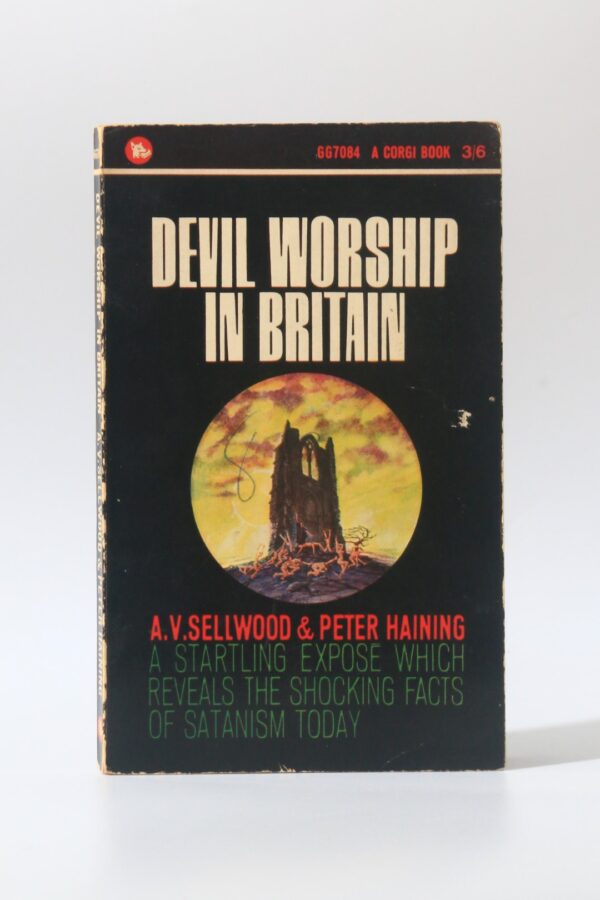
Lo Statuto della Compagnia del Santissimo Sagramento in S. Nicolà dei Perfetti (Statutes of the Confraternity of the Most Holy Sacrament), in Italian and Latin, decorated manuscript on parchment
CAREFULLY WRITTEN AND DECORATED UNPUBLISHED MANUSCRIPT FROM AN ITALIAN CONFRATERNITY. In Italian and Latin, decorated manuscript on parchment, Italy (Rome), c. 1736-1745. Dimensions 231 x 167 mm., 27 folios, complete, written in black ink in italic and in an upright script modelled on Roman font in 25 long lines, red rubrics, full decorative borders in black ink throughout, five 3-line and one 4-line initials in red ink with acanthus, one 6-line initial in black ink with acanthus, decorative tail pieces throughout. BINDING: original quarter leather binding with decorative paper covered boards. TEXT: This manuscript contains the statues for a confraternity in Rome, recording its regulations including the election of its chief officers, maintenance of the archives, care for the sick, funerary arrangements for deceased members, and so forth. Carefully written and decorated, this manuscript illustrates the interesting continuation of manuscript culture (in this case clearly influenced by the aesthetics of contemporary printed volumes) in the eighteenth century. PROVENANCE: Written and decorated in Rome for the Confraternity of the Holy Sacrament in S. Nicol dei Perfetti, Rome; the Statutes were originally ratified c. 1736; additions at the end of the manuscript confirming reforms to the statutes are dated 1744-1745; auction and other notes, all in pencil, in several hands; later owned by Kroch's Bookstore, Inc., Chicago (typed description from Kroch's bookstore laid in). CONDITION: slight darkening to edges, binding with slight wear to corners of boards, first quire loosened from bottom cord, in otherwise very good condition. Full description and images available. (TM 1093)- $6,500
- Les Enluminures | 2 m
- $6,500

Latin Bible, part (Pauline and Catholic Epistles, Acts, Apocalypse); NICHOLAS OF LYRA, Postillae (Commentaries on the Pauline and Catholic Epistles, Acts, Apocalypse); in Latin, decorated manuscript on paper
Nicholas of Lyra MANUSCRIPT COMBINING A LATIN NEW TESTAMENT AND COMMENTARIES BY NICHOLAS OF LYRA. In Latin, decorated manuscript on paper, Northeastern Netherlands or Northwestern Germany, c. 1450-1475. Dimensions 275 x 198 mm., 383 folios, apparently complete, written in a formal cursive gothic bookhand without loops in two columns of 38 lines, red initials, nine- to fifteen-line blue or parted red and blue initials, added running titles, which continue to part two of the volume; ff. 146-end, copied in a very neat controlled hybrida script, red initials 3- to-10 line (occasionally blue), a few with pen decoration,10-line red initial, six 10-line parted red and blue initials. BINDING: seventeenth century(?) plain vellum over pasteboard with yap edges. TEXT: This sizeable volume combines a copy of the New Testament, lacking only the Gospels, with the Commentaries by Nicholas of Lyra on the same books of the New Testament. Although possibly of independent origin, these two sections are contemporary and were united very soon after they were copied. This is the only manuscript we know of that combines the two within one volume, but it is easy to see how readers benefited greatly by having these complementary texts together. PROVENANCE: Evidence of the script, decoration, and watermarks suggests the first part of the manuscript, with the biblical text, was copied in Northwestern Germany, c. 1450-1475; evidence of the watermarks and script suggest the second half of the manuscript with Nicholas of Lyra's postillae likely copied in the Northeastern Netherlands or in Northwestern Germany, c. 1460-1470; belonged to Johann Heinrich Joseph Niesert (1766-1841); later owners, Isaac H. Hall and S. B. Pratt. CONDITION: In very good overall condition, f. 1 slit at the bottom inner margin, frayed in the outer margin, ff. 145v-146 paper noticeably darkened, f. 383 frayed at the gutter, few worm holes, rare stains from damp top margin in the second half, last few pages a bit fragile in the inner margin, vellum at the front now detached from the pasteboard and curling up, front and back covers rather dirty and scuffed. Full description and images available. (TM 1089)- $70,000
- Les Enluminures | 2 m
- $70,000

Viridarium Gregorianum sive Biblia Gregoriana, New Testament (A Garden or Bible of Gregory); in Latin, decorated manuscript on parchment
JACOBUS FOLQUERIUS (JACQUES FOUQUIER) FOURTEENTH-CENTURY MANUSCRIPT OF A RARE NEW TESTAMENT COMMENTARY COPIED BY A NAMED SCRIBE. In Latin, decorated manuscript on parchment, Southwest Flanders or Hainaut (Tournai?), c. 1350. Dimensions 240 x 170 mm., 120 folios, complete, catchwords in red and brown ink, quire signatures, written by a single scribe in a university bookhand, scrolling cadels at top lines sometimes in human and animal forms, numerous red and blue/black penwork initials of five to seven lines. BINDING: Nineteenth-century marbled boards and doublures, parchment covering corners and spine, spine title in red and black with filigreed decoration in red. TEXT: A New Testament commentary, Jacobus Folquerius's Viridarium Gregoriana , mined from many of Gregory the Great's works, drawing occasionally on Alulfus of Tournai's Gregorialis . The text is known in only three other manuscripts; this copy was, until now, apparently unknown, and is certainly the only of its kind on the market. PROVENANCE: Based on the script, this manuscript was copied c. 1350 by a scribe trained in Southwest Flanders or Hainaut (Tournai?). The parchment's texture and penwork initials are also consistent with this region. The scribe, moreover, names himself on the final folio: "Hic liber est scriptus ludofus sit benedictus." Ludolfus is otherwise unknown. The Germanic name Ludolfus, coupled with the manuscript's northwestern physical features, is consistent with production in this region; an auction record indicates this manuscript was previously in a Bordeaux private collection, although the blue pencil note in English suggests an interruption in French ownership. CONDITION: some small spots and parchment discoloration occasionally clouding text, several original holes in parchment once stitched, rodent damage to bottom inner corner of last two quires, minor cockling of leaves due to tight binding, some chipping on binding cover, edges, and hinges, staining on front flyleaves and some ink transfer to flyleaves adjacent to book block, overall in good condition. Full description and images available. (TM 1054)- $85,000
- Les Enluminures | 2 m
- $85,000

THE WILDERNESS HUNTER. AN ACCOUNT OF THE BIG GAME OF THE UNITED STATES AND ITS CHASE WITH HORSE HOUND, AND RIFLE
ROOSEVELT, Theodore (Teddy ROOSEVELT) Quarto (8" x 11-1/4") in the original gilt-decorated cream cloth; xvi, 472 pages. Illustrated with a frontispiece plate, drawings at the chapter heads and tails, and 23 full-page plates by A. B. Frost, Henry Sandham, J. Carter Beard, Frederick Remington, and Harry Eaton. This is copy #122 of only 200 copies SIGNED by the author on the limitation page. One of Roosevelt's scarcest and most desirable books. Mild soiling to spine; red ribbon marker still present. Lovely, clean, tight copy, about Fine- $10,625
- Charles Agvent | 3 m
- $10,625

Palissy in Prison and other verses
Strange (Edward Fairbrother). One of 200 copies signed and numbered by the author and with printed date "June" crossed through b him and changed to "November 1892" Lower wrapper detached, upper hinge repaired, wrappers somewhat soiled and frayed, pieces missing from spine, otherwise a very good copy; errata-slip tipped in at end. Presentation Copy, inscribed on the fly-leaf "Julian Marshall Esq., Edward F. Strange", text with a few typographical corrections in his hand Scarce and fragile, perhaps Uranian, only the British Library, Cornell and the Australian National University recording copies. Strange was an assistant keeper at the Victoria and Albert Museum. Original dark brown wrappers lettered in black, uncut- $164
- Bertram Rota Ltd | 3 m
- $164

Children of Hertha and other poems
Whistler (Laurence). Title and illustrations by Rex Whistler One of 300 numbered copies Very slight wear to wrappers and a little cockling, but a very nice copy; numbers in ink on inner lower wrapper Original wrappers decorated with stars with printed label- $478
- Bertram Rota Ltd | 3 m
- $478

Description du premier voyage faict aux Indes Orientales par les François en l¿An 1603. [including separate title pages for the Description et Remarque de quelques animaux, episceries, drogues¿ and the Traicte du Scurbut].
François Martin, de VITRÉ (4) ff., 134 (i.e. 131) pp. Bound in contemporary vellum, housed in modern book box. Signature I misbound. Impeccable copy, excellent. Extremely rare first edition of the first French account of the East Indies to appear in print (cf. Lach & van Kley, III: 373), here in an impeccable copy bound in early vellum. The work is that of the French adventurer François Martin de Vitré (c. 1575-c. 1631), who, upon his return to Brittany from the East Indies in 1603, prepared this lively account at the behest of King Henry IV (1553-1610). Martin¿s narrative inspired Henry in 1604 to establish the first iteration of the French East India Company (Compagnie des Indes Orientales) with designs on exploiting the treasures described in the present work (cf. Lombard, ¿Martin de Vitré, Premier Breton à Aceh¿). Likely enlisted as ship¿s surgeon aboard the Croissant, François Martin of Vitré, along with several companions from Saint-Malo and Laval, sailed from Britanny in 1601, rounding the Cape of Good Hope in May of that year. The Croissant¿s companion ship, the Corbin, wrecked in the Maldives, but Martin eventually succeeded in reaching Ceylon and trading with the Aceh in Sumatra. Upon his return journey he was captured by the Dutch at Cape Finisterre but finally returned to France in 1603. In his preface Martin summarizes the European powers¿ incursions in the East and laments the tardiness of the French to exploit the region¿s riches: ¿This has made me deplore the defect of the French, who more than any other nation are provided with a vivacity of spirit and a formidable worthiness, but who have nevertheless languished for so long in a slumber of idleness, ignoring information on the treasures of the East Indies with which the Portuguese and Spanish have enriched themselves¿ (p. 3). In the first two sections of the work Martin gives ample space to the discussion of flora, fauna, and commercial matters relevant the regions he visits (aromatic plants, spices, crops, the elephant, rhinoceros and tiger, the crocodile, tortoise and bird of paradise, livestock, the hunt, woods, weights and measures, currency, etc.), but he also includes a great deal of anthropological detail. Evidently the stereotypical red-blooded Breton seafarer, Martin, in his chapter on the ¿habits and customs we observed during our stay in the Indies¿ (pp. 38-66) dwells mainly on women ¿ the prostitution of premarital women, their perfumes, their bathing rituals, their medicines, and their punishment for adultery. He also notes gestures of salutation (two hands together before one¿s forehead), marriage customs (¿they can marry seven wives if they have the means to support them¿), and gives detailed reports on the traditions and inner workings of both Hinduism and Islam. He notes Turkish merchants to be frequent visitors to these lands, and writes of seeing a cannon of Chinese manufacture. Martin¿s intriguing 4-page dictionary of words useful for the traveler includes a section on counting in Malagasy, the language of Madagascar. The volume also contains a brief but significant ¿dictionary¿ of the Malay language, described here as ¿Elegant and easy to learn, like Latin¿ (¿fort beau & facile a aprendre ¿ comme le latin en leurope¿). Finally, in his presumed role as ship¿s surgeon, Martin penned a third section treating scurvy, recommending among other cures the use of citrus fruits and an aqueous preparation of alum. OCLC lists only two U.S. copies of this 1604 first edition: NYPL and the Minnesota¿s Bell Library (lacking 2 prelims). The work was reprinted in 1609, and of this second edition OCLC locates U.S. copies only at Harvard and the Boston Athenaeum. * Atkinson 444; Brunet, Supl. I, 920 (citing only the second edition); cf. also Denys Lombard, ¿Martin de Vitré. Premier Breton à Aceh (1601-1603),¿ Archipel 54: 3-12 (1997).- $50,000
- Martayan Lan | 4 m
- $50,000

SS. Apostolorum et Evangelistarum Icones cum suis parergis.
BARBÉ, Jean-Baptiste / VAN LOON, Theodoor Single-sided engravings, (1) engraved title, (20) engravings. Unbound, fixed with small staples at top edge. Minor marginal handsoiling and spotting, small marginal holes to a few leaves, minor edge wear, light browning to a few leaves. Generally very good. Very rare first edition of a set of engravings by the Antwerp printmaker Jean-Baptiste Barbé (1578-1649) after the designs of Theodoor van Loon (c.1581-1649), a Flemish painter noted as an early stylistic follower of Caravaggio (1571-1610). The work presents bust-length portraits of the Holy Family, the Four Evangelists, and the Twelve Apostles, each set within a fancifully designed sculptural frame, with the wording of the collection¿s title ¿ Icons with their Frames (¿parergis¿)¿ emphasizing the importance of the relationship between painted image and its enclosing frame. While the strong shading of some plates recalls Caravaggio¿s tenebrism, facial types, which gaze sweetly into the distance, are perhaps more indebted to those of Guido Reni (1575-1642), who was working in Rome and at the height of his popularity around the time these engravings were produced. Each ¿icon¿ is depicted with his attribute or an instrument of martyrdom (e.g., Peter¿s keys, Luke¿s ox, Andrew¿s cross), and the frames often echo these iconographic connections (e.g., herms flanking the portrait of James the Major are dressed as pilgrims). The emphasis on framing devices here is likely related to the rise in an interest in Christian archeology that began around 1600 and greatly influenced the way venerable images were treated in the remodeling of major churches and their altarpieces: For example, Theodoor van Loon certainly would have known his countryman and exact contemporary Peter Paul Rubens¿ (1577-1640) early Roman commission to enclose the ancient Santa Maria in Vallicella icon at Chiesa Nuova in an elaborate, pictorial altar frame (1606-08). This suite of engravings by Barbé should not, therefore, be seen only as a collection of images suitable for personal devotion, but also as a thoughtful visual treatise concerning the way artists were asked to confront and re-present early Christian art and iconography in the first half of the seventeenth century. Interestingly, these engravings are prominently dedicated on their title page to Wenceslas Cobergher (1560-1634), a painter, architect, engineer, theorist of institutional pawn shops (monti di pietà), numismatist, and collaborator of van Loon who was deeply interested in Roman and early Christian antiquities and their use by contemporary artists. * Hollstein, Dutch and Flemish, vol. 1, p. 100, nos. 45-64; M. Funck, Livres belge à gravures, p. 356; I. Baldriga, et al., Theodoor van Loon: ¿Pictor ingenius¿ et contemporain de Rubens, 2011; T. Meganack, De kerkelijke architectuur van Vensel Cobergher in het light van zijn verblijf te Rome, 1998. OCLC and KVK locate copies at the National Gallery (D.C.), Clark Art Institute, BnF, and Vlaamse Erfgedbibliotheek (Antwerp).- $3,850
- Martayan Lan | 4 m
- $3,850

Holy Cats By Andy Warhol’s Mother
WARHOL, ANDY Holy Cats was created and drawn by Warhol's mother, Julia Warhola (1891-1972) in memory of her cat, Hester. Warhola sketched the line drawings and created the cursive captions in her own hand comically illustrating the great variety of feline personalities. The captioned drawings are each printed on colored pager totaling twenty pages plus full cover drawing on off white paper wrapping. Internal pages are fine. The rear cover shows a light center stain.The illustrated paper cover along the spine is broken at the center and upper and lower left edges, with slight cracking along inside covers. The book was privately printed one time in 1954 in a small edition and measures 9 x 6 inches. After a successful career as a commercial illustrator, Warhol became famous as a painter, avant-garde filmmaker, record producer, author, and public figure.- $8,580
- $8,580
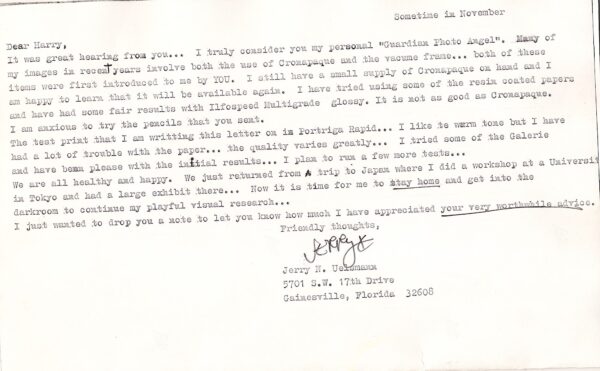
UELSMANN, JERRY, Test Print Photograph with Typed Letter Signed on verso
UELSMANN, JERRY Uelsmann wrote, "Test Print 1979," on the back of his 11 x 14 inch photograph printed on Portriga Rapid paper. He explains that many of his recent images, "involve the use of of Cronapaque and the vacume frame.both of these items were first introduced to me by YOU.I have tried using some of the resin coated papers and.Ilfospeed Multigrade glossy. not as good as Cronapaque." Uelsmann continues to explain the photographic print. "I like [the] warm tone but I have had a lot of trouble with the paper." He ends with personal news about his family trip to jJapan where he had a large exhibit in Tokyo and noting, "Now it is time for me to stay home and.continue my playful visual research." Above his typed name and address he signs, "Jerry." Uelsmann adds several hand written corrections and writes in the lower left corner, "test print 1979." He likely writes to fellow photographer Harry Callahan (1912-1999). The large photograph has been folded in half horizontally. The upper right corner shows slight bends. Cronapaque, a trademark of the DuPont de Nemours company (patent filed 1959), is a translucent graphic arts film [contact us for source] . Uelsmann ends with "Diane and I both hope this letter finds you in good health," and signs, "Friendly thoughts, Jerry." Diane [Diane Farris, the photographer] was Uelsmann's second wife whom he married in 1975. Some soiling on margins and bend on one corner, otherwise very good condition.- $1,320
- $1,320
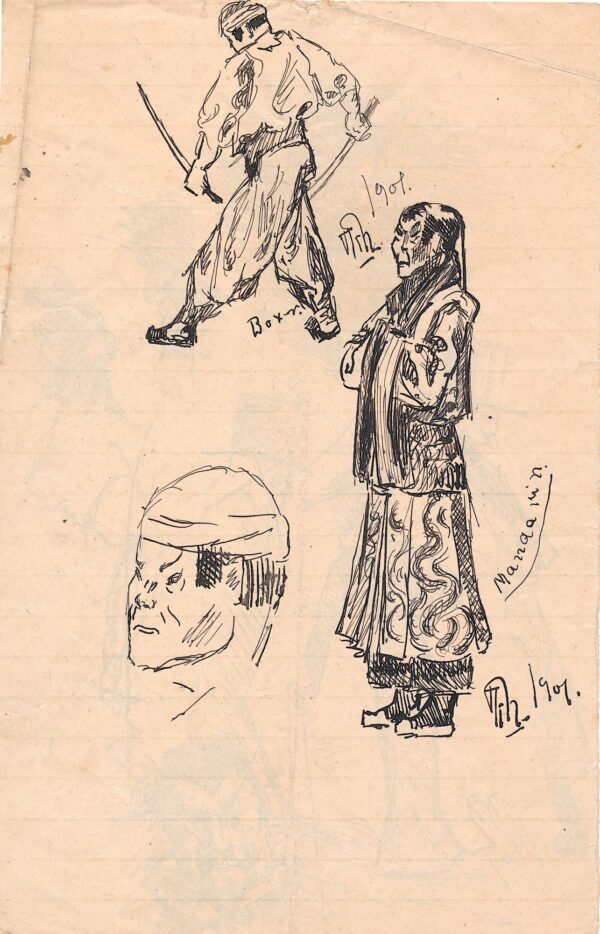
Kay Nielsen Original Sketches Signed
NIELSEN, KAY Nielsen's multi-signed sketches cover two sides of one sheet of lined paper. Three Original Sketches two signed with initials and dated, 1901. Nielsen drew two full length figures in Asian costume, titled each one, initialed and dated. He also drew the head of another male figure with cap. The drawings were rendered in ink, pencil and water color on an 8 x 5 1/4 inch sheet of faded lined paper. There are also sketches on the verso signed and dated in the same manner as on recto. The paper is evenly aged with a bend at the upper left and upper right not affecting the artwork. In addition to being recognized for his illustrations of classic fairy tales, Nielsen is also known for his collaborations with Walt Disney, 1937-41.- $2,200
- $2,200

DIE PSALMEN ÜBERSETZT UND ERLÄUTERT. 2 Teile in einem Band. Komplett.
Hirsch, Rabbiner Samson Raphael (ed.) 2 Teile in 1 Band (KOMPLETT) 3. Aufl. . ca. 620S. hebräischer und deutscher Text. Einige leichte Gebrauchsspuren am Einband. Schnitt teils leicht gebräunt. Hebräischer alter Besitzername auf Vorsatz. Innen frisch.- $100
- M.POLLAK ANTIQUARIAT | 6 m
- $100

Ducatus Wurtenbergici cum Locis limitaneinis, iapote maxima parte Circuli Suevici praesertim Utroq. Marchionatu Badnsi et Sylva vulgo Nigra.
Homann, Johann Baptist Engraved double page (23 1/2" x 20 1/2 "), partially hand colored, large title uncolored cartouche in upper right corner. One sheet of a two-sheet map, but has a complete appearance. Expert tape repairs on verso at centerfold, slight aging and browning; otherwise about near fine with a strong impression. Johann Baptist Homann (1663-1724) was considered the father of German mapmaking, and in 1715 was actually appointed the Geographer to the Emperor. He founded his mapmaking business in 1702, and he would produce several major atlases between 1707 and 1716. This is a detailed and attractive map of part of the southwestern part of Germany that includes Wuerttemberg. While the map is one sheet of a two-sheet map, it has a complete appearance, and an elaborate title cartouche. Our inventory includes both sheets but as seperate maps. Van De Gohm: Antique Maps. Bagrow: History of Cartography.- $225
- $225

Original Vintage Poster WRAC Why Not You Territorial Army
Original vintage British military recruitment poster for the Women's Royal Army Corps (1949-1992) Territorial Army - Why not You? Join the WRAC (TA) and make your spare time worth while - featuring a young lady in army uniform smiling to the viewer against a shaded blue background with space for information below - You nearest unit is at: - next to the TA badge. Prepared for The War Office by The Central Office of Information. Printed for H.M. Stationery Office by Jordison & Co Ltd, London and Middlesbrough. Excellent condition, punched holes on the top edge with string. Size: 38x25- $357
- $357

Rand’s Little Giant, Slugger and Economizer Rock Drills, Improved Air Compressors, Air Hose, Steam Hose, Air Receivers, Pipe and Fittings, Engines, Boilers, Drill Steel.
(TRADE CATALOG: MINING) First edition. Oblong quarto (12 x 9 1/4 inches). [40] pp. and with numerous very high quality engravings of men and machinery throughout. Publisher's pale yellow wrappers with the front cover bearing an image of en working a mine and the back with an image of a rock drill. Very old central fold (perhaps for mailing), front cover with three old and small taper repairs. A very clean copy of this scarce trade catalog. OCLC only locates one copy.The Rand Drill Company, established in the 1870s by brothers Jasper and Addison Rand and the first to see the benefits of Ingersoll's pneumatic drill, became a significant name in the development and manufacturing of pneumatic drills and other mining equipment. Simon Ingersoll was an American inventor who created the steam-powered percussion rock drill, which replaced the hand drill and was a major advancement in the mining and construction industries. Simon Ingersoll founded Ingersoll Rock Drill Company in 1871 in New York, and in 1888, it combined with Sergeant Drill to form Ingersoll Sergeant Drill Company. In 1905, Ingersoll-Sergeant Drill Company merged with the Rand Drill Company to form the mega-corporation Ingersoll Rand. Ingersoll himself died penniless.- $225
- Nat DesMarais Rare Books | 6 m
- $225
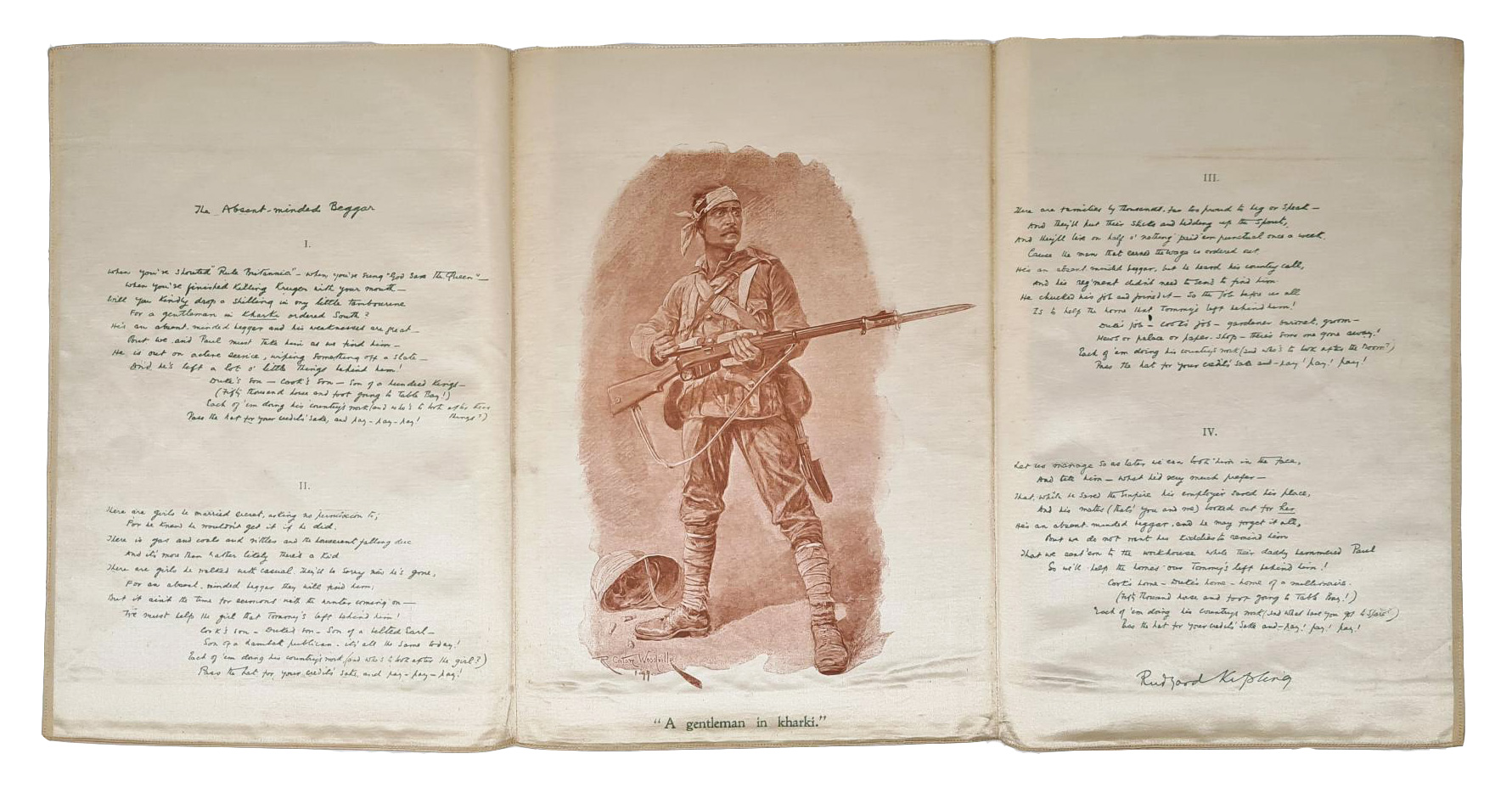
The Absent-Minded Beggar Copyright in England and the United States by the Daily Mail Publishing Co.,
KIPLING, Rudyard. 'This souvenir is presented by Mrs. Langtry on the occasion of the 100th performance of the "Degenerates" at the Garrick Theatre. For permission to use Mr. Kipling's poem Mrs. Langtry has made to the "Daily Mail" a contribution of £100 for the benefit of the wives and children of the Reservists fighting in South Africa.' Kipling wrote 'The Absent-Minded Beggar' to assist the Daily Mail's 'Soldiers' Families Fund', established to raise money for comforts such as tobacco, cocoa, and soap for the troops, and clothing and postage for parcels from home for their families. Many of the men mobilised were ex-soldiers in permanent employment for whom returning to military duty meant a significant cut in their income, and there was no legislation to protect Reservists' employment. Poverty hit many families when the lifestyle maintained comfortably on a workman's wage of twenty shillings could not be kept up on the infantryman's 'shilling a day': When you've shouted "Rule Britannia" when you've sung "God Save the Queen" When you've finished killing Kruger with your mouth Will you kindly drop a shilling in my little tambourine For a gentleman in kharki ordered South? The poem was first published in the Daily Mail on 31 October 1899; both Kipling and the artist Richard Caton Woodvillethe image of a defiant Tommy was commissioned to accompany Kipling's poem, and endlessly reproducedcontributed their fees, and the Fund raised £100,000 in three months. While not rare in commerce, this is a particularly nice example, well preserved. Folding cream silk 'triptych' (287 × 588 mm; 287 × 200 mm when folded), printed in green, the poem in manuscript facsimile, portrait of Kipling on the front and Richard Caton Woodville's 'A gentleman in kharki' inside printed in sanguine; the silk stitched over three pieces of card, as issued; in very good condition.- $376
- Simon Beattie | 6 m
- $376
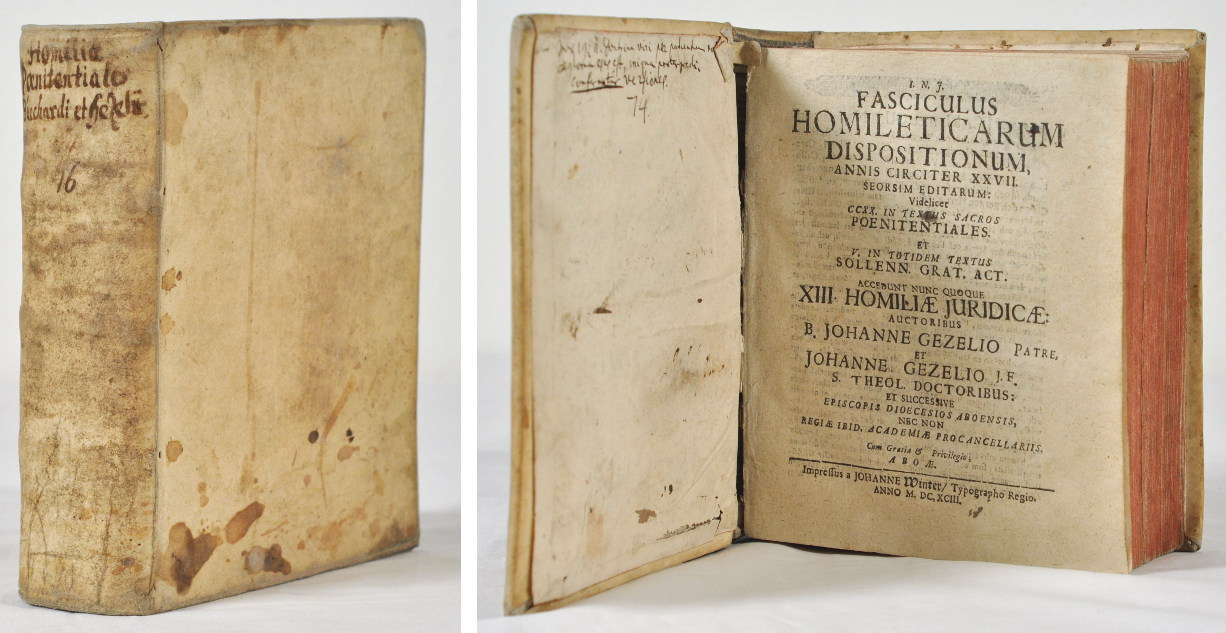
Fasciculus homileticarum dispositionum, annis circiter XXVII seorsim editarum: videlicet CCXX in textus sacros poenitentiales. Et V in totidem textus sollenn. grat. act. Accedunt nunc quoque XIII homiliæ juridicæ: auctoribus b. Johanne Gezelio patre, et Johanne Gezelio j.f.
GEZELIUS, JOHANNES d.ä. & GEZELIUS, JOHANNES d.y. Åbo, J. Winter, 1693. 4:o. (16),136,136-41,141-51,151-353,336-37,356-796,(38) pp. Contemporary vellum, soiled, with old handwritten title on spine. Red edges. Ink stains on front cover. Insert loose at front hinge, where a brochure has been cut out. Rear hinge also a little weak. Some foxing in margins. Multiple underlinings and margin notes. Index leaves at the end with dampstains in upper margin. Contemporary latin dedications on pastedowns.Collijn Sveriges bibliografi 1600-talet 318. "Svenskt biografiskt lexikon" writes: "As vice-chancellor at Åbo akademi G took a special interest in the theological faculty and in making the teaching there more effective. For a number of years he held lectures in homiletics and supervised preaching exercises. He attached great importance to the morning service sermon and published outlines for sermons that were frequently used by the clergy, to the benefit of the preaching within the diocese". [Our translation.] Johannes Gezelius the elder (1615-90) died before the present work was published and it was finished by his son, Johannes Gezelius the younger (1647-1718), who succeeded his father as bishop in Åbo.- $1,006
- $1,006
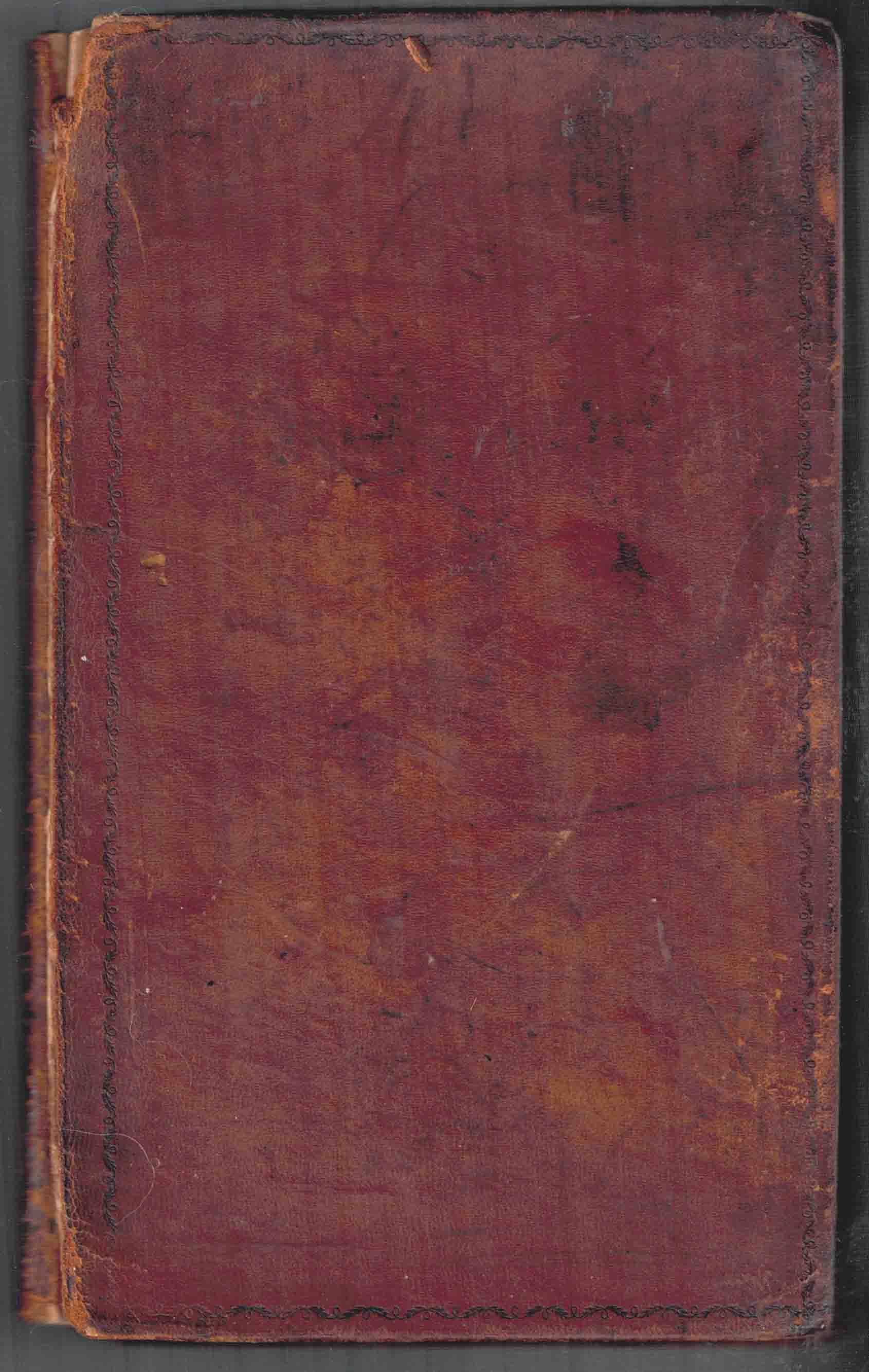
Rules of Discipline of the Yearly-Meeting, held on Rhode-Island, for New-England. Printed by Direction of the Meeting
New England Yearly Meeting of Friends 21x13 cm. Contemporary full calf, front board detached. Water stain at bottom in the first half of the book, light soiling and foxing throughout. xvi, 156 pp. First published by Abraham Shearman in 1809 and re-printed by direction of the Meeting by B. Lindsey & Co. in 1826. Shaw & Shoemaker 24639, OCLC 191256156 & 9460557, AAS 259471.- $125
- High Ridge Books, Inc. | 6 m
- $125
![Regiones sub Polo Arctico [Map of the North Pole]](https://rarebookinsider.com/wp-content/uploads/2024/09/31970757742.jpg)
Regiones sub Polo Arctico [Map of the North Pole]
Willem and Johannes Blaeu Original hand-colored engraving from Willem and Johannes Blaeu's Toonel des Aerdrycks ofte Nieuwe atlas, dat is Beschryving van alle Landen. the Dutch edition of Theatrum Orbis Terrarum . Early state with Groenlandia not yet labeled. Text to verso (see image). The page measures approximately 23.5 x 20 in (60 x 51 cm), with the map measuring 20.75 x 16.25 in (53 x 41 cm). Minor creature damage to the lower margin, along with paper repair (see image).- $1,200
- $1,200

Le chiffre de la peinture. L’oeuvre de Valerio Adami
Michel Onfray - Valerio Adami in 8 broché, non coupé, 16 illustrations couleurs, hors-texte de Valerio Adami. Édition originale tirée à 60 exemplaires enrichis d'une sérigraphie en couleurs de Valerio Adami, signée et numérotée par l'artiste. On joint un exemplaire du tirage ordinaire.- $227
- La Basse Fontaine | 6 m
- $227

Stances pour le peintre Alberto Magnelli.
André Verdet In 8 en feuilles sous chemise d'éditeur, 22 pages , 1 lithographie en couleurs de Kijno numérotée et signée. Un des 85 exemplaires de tête comprenant une lithographie de Kijno, enrichi d'un envoi de Verdet. Quelques rousseurs.- $113
- La Basse Fontaine | 6 m
- $113

L’oeil constant
André Verdet - Jean Miotte In folio en feuilles. Poème d'André Verdet illustré de quatre lithographies en couleurs pleine page, signées deJean Miotte. Tirage limité à 90 exemplaires, celui-ci un des 15 exemplaires d'artiste, enrichi d'un dessin d'André Verdet. Quelques rousseurs.- $397
- La Basse Fontaine | 6 m
- $397

General Hugh Mercer’s WillNoting the Plantation he Purchased from George Washington (Ferry Farm, Washington’s Boyhood Home), and Instructions to Executors to “hire negroes” to Work the Plantation for the Benefit of his Wife and Children
REVOLUTIONARY WAR. SLAVERY. GEORGE WASHINGTON. HUGH MERCER Manuscript Document, Contemporary Copy of Last Will and Testament, March 20, 1776, Fredericksburg, Virginia. 4 pp., 7 1/2 x 11 5/8 in. "I direct that after my decease my dear Wife Isabella (if she survive me) and my children do reside on my plantation in King George County adjoining to Mr James Hunter's Land which Plantation I purchased from General George Washington and that my Executors hereafter named out of my personal Estate purchase or hire negroes as they shall think best to work the said Plantation.""I further direct my Books Drugs surgical Instruments shop utensils and Furniture to be sold and also such Household Furniture Negroes or stocks of Cattle and Horses as may appear to my Executors hereafter named to be for the benefit of my Personal Estate."Written shortly after Hugh Mercer became the colonel of the 3rd Virginia Regiment of the Virginia Line, his last will and testament disposed of his real and personal property, including slaves among his wife Isabella Gordon Mercer and children, including one yet to be born.After playing a key role in the Battles of Trenton, in January 1777 at the Battle of Princeton, Mercer's horse was shot from under him, and he was mortally wounded. Vastly outnumbered and mistaken by the British for George Washington, he was ordered to surrender. Instead, he drew his sword, and was bayonetted seven times. He died nine days later. Historical BackgroundGeorge Washington's family moved to Ferry Farm, outside of Fredericksburg, in King George County, Virginia, in 1738, when he was six years old. His father died in 1743, while they lived there, and George Washington eventually inherited the farm and lived there with his mother and siblings until his early 20s. His mother lived there until 1772, when she moved to a house in Fredericksburg. After leasing the tillable and pasture lands of Ferry Farm for two years, George Washington sold it in April 1774 to Scottish physician and fellow French and Indian War veteran Hugh Mercer for £2,000 Virginia currency, due in five annual payments plus interest.Mercer was appointed colonel of what became the 3rd Virginia Regiment of the Virginia Line in January 1776. Both future President James Monroe and future Chief Justice John Marshall served as officers under his command. By June 1776, the Continental Congress had appointed him as a brigadier general in the Continental Army, and he left for New York to oversee the construction of Fort Lee on the New Jersey side of the Hudson River.Mercer played major roles in the First and Second Battles of Trenton on December 26, 1776, and January 2, 1777. While he was leading a vanguard of soldiers to Princeton on January 3, Mercer's horse was shot from under him. British soldiers mistook Mercer for Washington and ordered him to surrender. Instead, Mercer drew his saber and attacked though heavily outnumbered. The British troops bayonetted him seven times and left him for dead. General Washington rallied Mercer's men, pushed back the British regiment, and continued the attack on Princeton. Despite medical attention from Dr. Benjamin Rush and local Quakers, Mercer died nine days later from his wounds.In 1791, Painter John Trumbull used Mercer's son Hugh Tennent Weedon Mercer, who was five months old when his father died, as a model for the large painting, The Death of General Mercer at the Battle of Princeton, January 3, 1777, on which Trumbull worked for many years.Hugh Mercer (1726-1777) was born in Scotland as the son of a minister in the Church of Scotland. He studied medicine at the University of Aberdeen's Marischal College and graduated as a physician in 1744. He served as an assistant surgeon under Bonnie Prince Charlie and was present at the army's defeat at the Battle of Culloden in April 1746. He went into hiding and fled to America in 1747, settling in Pennsylvania, where he practiced medicine. During the French and Indian War, he joined a Pennsylvania regiment as. (See website for full description)- $12,500
- Seth Kaller Inc. | 6 m
- $12,500

California Constitution First Printing in Book FormOne of Earliest Printings in San Francisco
CALIFORNIA Constitution of the State of California. San Francisco: Office of the Alta California, 1849. 16 pp., 5 3/4 x 9 5/8 in. "We, the People of California, grateful to Almighty God for our freedom, in order to secure its blessings, do establish this Constitution." (p3)Art. I, "Sec. 18. Neither slavery, nor involuntary servitude, unless for the punishment of crimes, shall ever be tolerated in this State." (p4) Historical BackgroundIn January 1848, a carpenter first found gold at a sawmill owned by John Sutter on the South Fork American River northeast of Sacramento, launching the California Gold Rush. As news of the discovery spread, prospectors flocked to the new U.S. territory of California, 81,000 arriving in 1849 and another 91,000 in 1850. Over the next seven years, approximately 300,000 people came to California seeking gold or supplying prospectors. The Treaty of Guadalupe Hidalgo, which ended the Mexican War in February 1848 made California, Nevada, Utah, and Colorado and parts of New Mexico and Arizona American territory.On June 3, 1849, Brigadier General Bennett C. Riley (1787-1853), the ex officio governor of California under U.S. military rule, issued a proclamation calling for a constitutional convention and the election of delegates to it on August 1. Voters elected 48 delegates, who convened in Monterey for six weeks in September and October 1849. William E. Shannon (1822-1850) of Sacramento proposed a section declaring that neither slavery nor involuntary servitude "shall ever be tolerated in this State," which was unanimously adopted and made part of the bill of rights in the first article. The constitution also guaranteed the right to vote to "every white male citizen of the United States, and every white male citizen of Mexico, who shall have elected to become a citizen of the United States" who was also at least twenty-one years old. The office of the Alta California newspaper in San Francisco printed this pamphlet for California's citizens to review before casting their ballots. Voters ratified the new state constitution on November 13. On December 1, 1849, the issue of the Alta California for the Steamer Unicorn reported early results on the ratification of the constitution and election of state officers: "From every precinct yet heard from, the meagerness of the vote is accounted for by the fact that the rain fell in torrents. Some complaint is also made that the printed copies of the Constitution were not properly circulated, and that is said to be one reason of the large vote against it in the Sacramento District." According to the precincts reporting from the Sacramento District, 5,002 voted in favor of the constitution and 603 against it. The final vote of the state was 12,061 for the constitution, and 811 against it.The rapid expansion of California's population inspired discussions of its status within the Union. In his annual message to Congress in December 1849, President Zachary Taylor noted the constitutional convention recently held and his expectation that California would soon apply for statehood, which he encouraged. Two months later, President Taylor submitted this California Constitution and a proposal to admit California as a new state to Congress. Taylor's death on July 9, 1850, elevated Millard Fillmore to the presidency. Fillmore supported the Compromise of 1850, engineered by Senator Henry Clay of Kentucky. One of the five acts that composed the Compromise of 1850 was "An Act for the Admission of the State of California into the Union." On September 9, 1850, Fillmore signed the act into law, and California became the 31st state in the Union.The Alta California began publication on January 4, 1849, as a weekly newspaper. Edward C. Kemble, Edward Gilbert, and George C. Hubbard were the first publishers. The newspaper became a daily in January 1850 and continued publishing until 1891.Condition: Small accession number stamped in margin of upper cover; scatt. (See website for full description)- $17,500
- Seth Kaller Inc. | 6 m
- $17,500
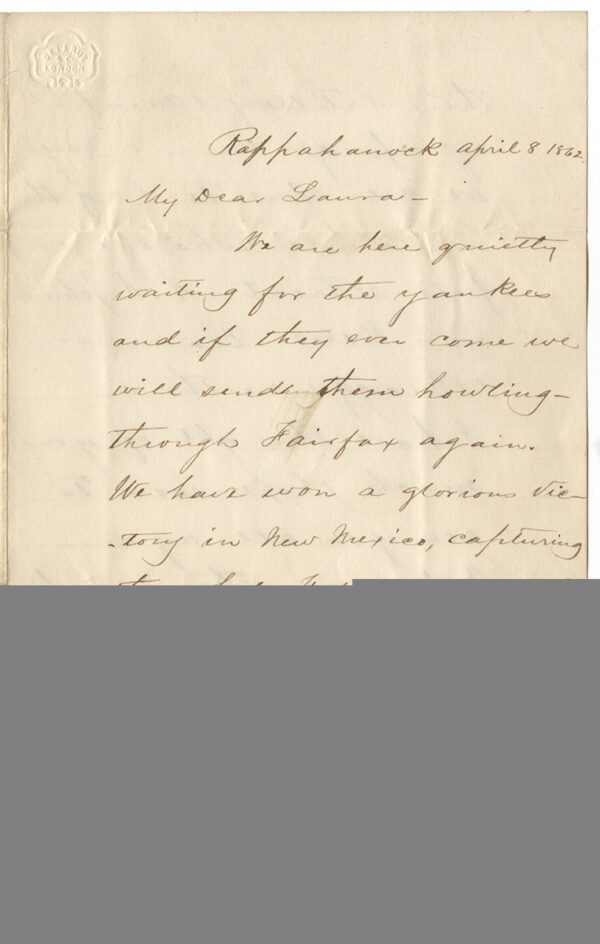
J.E.B. Stuart Writes to Legendary Confederate Spy Laura Ratcliffe
J.E.B. STUART Autograph Letter Signed "S", to Laura Ratcliffe. April 8, 1862. 3 pp., 3 7/8 x 6 in. Full of braggadocio, Confederate cavalryman J.E.B. Stuart gives early mistaken reports of the Battle of Shiloh to an informant, the famous Confederate spy Laura Ratcliffe."We are here quietly waiting for the yankees and if they ever come we will send them howling." Complete Transcript Rappahannock April 8 1862My Dear Laura - We are here quietly waiting for the yankees and if they ever come we will send them howling - through Fairfax again. We have won a glorious victory in New Mexico, capturing the whole Federal command 5000 - under Genl Canby. We have also won a glorious victory near Corinth on the Tenn. Captured 3 genls Smith McClernand & Prentiss, & six thousand prisoners, all [2]their artillery & camp equipage & rumor says we are sure to bag the remainder who are in full retreat, A.S. Johnston was killed. Beauregard & Bragg were there - I have thought of you much, & hope soon to see you all again. Before another week we expect to win another glorious victory. Hurrah! Hurrah!! I wish I could see you read this -- [3] My regard to your folks - The bullet-proof is all right. Yours ever truly S__[envelope:] Miss Laura Ratcliffe / Beauty's Bower Historical Background Laura Ratcliffe lived in Fairfax, Virginia, and her home was sometimes used as headquarters by the ranger John Singleton Mosby. Ratcliffe used to hide messages and money for Mosby, and once hid him from a search party of Federal troops. Among other Confederate officers to whom she offered various types of support was J.E.B. Stuart, who corresponded with her and occasionally even sent her poetry.Stuart rapturously recounts a recent series of Confederate victories and anticipates others. "We are here quietly waiting for the Yankees and if they ever come we will send them howling through Fairfax again." Apparently dependent on early newspaper reports, Stuart is mistaken about the Battle "near Corinth." On April 4 and 5, 1862, after near-victory on the first day, General Albert S. Johnston's Army of Tennessee was defeated by Ulysses Grant at the Battle of Shiloh. Stuart was correct in noting, however, that Johnston was killed at this battle.The envelope for the letter bears the engraved address of "Head Quarters Cavalry Brigade, Army of the Potomac." The Confederate Army of the Potomac was commanded by P.G.T. Beauregard, but in June 1862 it was renamed as the First Corps of the Army of Northern Virginia when Robert E. Lee assumed command. Beauregard had been sent west to be second-in-command to Albert Johnston, and led the Army of Tennessee on the second day of Shiloh. Stuart's cavalry was soon transferred from north central Virginia (this letter is dated "Rappahannock") to the Peninsula, where Union General George McClellan had landed his Army of the Potomac in an attempt to advance on Richmond from the southeast with the help of Union Navy transport vessels.Laura Ratcliffe (1836-1923) was a legendary Confederate spy who operated a safe house in Fairfax County, Virginia, just outside Washington, D.C. She met cavalrymen J.E.B. Stuart and John S. Mosby early in the war, when she and her sister were nursing wounded soldiers, and soon began providing information on Union troop activity as the Confederate Army was forced south. In 1862 and 1863, when Stuart commanded Robert E. Lee's entire cavalry corps, he made several raids on the Fairfax County area, often visiting Laura at her home. In the winter of 1862, Mosby was granted permission to stay with Ratcliffe and nine soldiers. There was a rock at the top of Squirrel Hill on her property where she would leave messages for Mosby or Stuart. She was never charged with a crime.James Ewell Brown ("Jeb") Stuart (1833-1864) was the most famous Confederate cavalryman and one of General Lee's principal lieutenants in the Army of Northern Virginia. A Virginian, he graduated from West Point in 1854 and gained use. (See website for full description)- $7,800
- Seth Kaller Inc. | 6 m
- $7,800
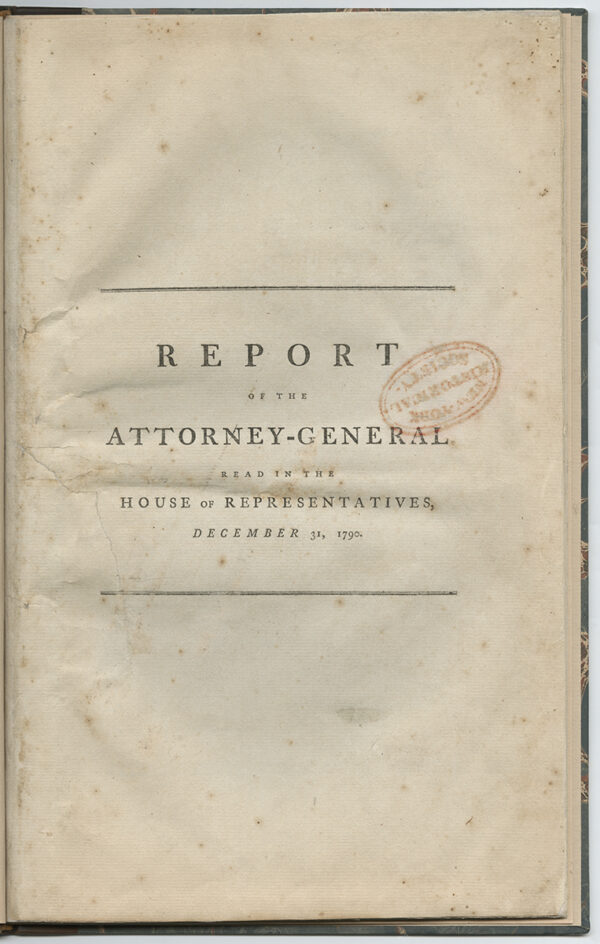
The Justice Department’s First Publication: Attorney General Edmund Randolph’s Suggestions to Improve the New Federal Judiciary, Including Supreme Court Fixes
EDMUND RANDOLPH Report of the Attorney-General. Read in the House of Representatives, December 31, 1790. Philadelphia: Francis Childs & John Swaine, 1791. 32 pp., Folio 8 x 13 in. The House of Representatives asked Attorney General Edmund Randolph to report on the working of the system established by the Judiciary Act of 1789. Randolph responded with this report, delivered on December 27, 1790, provided criticisms and suggestions that became a blueprint to improve the Federal judiciary. Specifically, Randolph wanted Congress to assert the exclusive jurisdiction of federal courts in certain areas; to relieve Supreme Court justices from the duty of presiding in circuit courts; and to adopt explicitly the common law of the United Kingdom as a basis for judicial decisions unless superseded by specific American legislation. The latter two-thirds of the report presents Randolph's proposal for "A Bill for amending the several Acts concerning the Judicial Courts of the United States," with his explanatory notes. Before Congress acted on Randolph's suggestions, in August 1792, all of the Supreme Court justices complained in a letter to President George Washington that circuit travel was too onerous. In response, Congress passed the Judiciary Act of 1793 (see #26594) that required only one, rather than two, justices to sit in each circuit court. Congress did not relieve the justices of circuit-riding duties until 1911. Excerpts"I am persuaded that time and practice can alone mature the judicial system." (p1)"If the United States, as far as they can be a party defendant, should happen to be so, their own courts can alone judge them. To drag a confederate before the courts of one of its members, would reverse the plain dictates of order; hazard the most critical interests of the union upon the pleasure of a single state; and enable every individual state under the pretext of a forensic sentence, to arrogate the general sovereignty." (p4)"We are then led to conclude, that the judiciary of the United States have exclusive jurisdiction in the following cases."1. In those of strict admiralty and maritime jurisdiction."2. Where the United States are a party defendant."3. Where a particular state is a party defendant."4. Where lands are claimed under grants of different states."5. In treason, as described by the constitution, and other crimes and offences created by the laws of the United States, but not consigned to the state tribunals."6. In rights created by a law of the United States, and having a special remedy given to them in federal courts." (p5)"Judicial uniformity is surely a public good, but its price may be too great if it can be purchased only by cherishing a power, which to say no more, cannot be incontestably proved." (p7)"A third alteration, which the Attorney-General cannot forbear to suggest, is, that the judges of the supreme court shall cease to be judges of the circuit courts." (p7)"If the judge, whose reputation has raised him to office, shall be in the habit of delivering feeble opinions, these reports will first excite surprise, and afterwards a suspicion, which will terminate in a vigilance over his actions." (p9)"in one aspect the existence of the common law, as the law of the United States, is equivocal. some parts of the common law.will be estranged from our system. To cut off then such altercation, is not unworthy the care of Congress. It is true indeed, that there ought to be a repugnance to naturalize the statute book of a foreign nation, even for a moment. But the fact is, that the United States have not yet had sufficient leisure to disengage themselves from it, by enacting a code for themselves. The time will come (perhaps it has already come) when such a work will be indispensable. But until it shall be completed, it will be far less disgraceful to accept, under proper restrictions, some part of our law from an alien volume, with which every state is well acquainted, and to which . (See website for full description)- $18,000
- Seth Kaller Inc. | 6 m
- $18,000

Rare Abraham Lincoln 1860 Campaign Sash for Rally at Boston’s Faneuil Hall
ABRAHAM LINCOLN Portrait Sash from Faneuil Hall Rally, May-November, 1860, Boston, Massachusetts. 1 p., 29 x 2 1/4 in. It features a portrait of Lincoln engraved from an 1858 photograph taken in Springfield by Christopher S. German. The first owner wore this sash at one or more of the Lincoln Rallies during the 1860 presidential campaign season. The two most prominent were at the beginning and end of the season. Historical BackgroundOn May 24, 1860, an "immense meeting" opened the Republican campaign in Massachusetts. The Daily Advertiser reported, "Faneuil Hall never rocked under the feet of a larger, a more unanimous, patriotic and enthusiastic audience, than filled its walls to overflowing last evening. The enthusiasm that was kindled, will spread throughout the country, and bear Lincoln and Hamlin in triumph to the goal."[1]On October 16, 1860, Wide Awake and other Republican groups from throughout New England again assembled in Boston for a "grand Republican demonstration and torchlight procession." William Lloyd Garrison's Liberator called it "the most brilliant and imposing political demonstration ever witnessed in Boston on any occasion" and asserted that ten thousand Wide Awakes "all in full dress" paraded through the streets of Boston, including several hundred African Americans.[2]We aren't aware of any other 1860 presidential campaign sashes with Lincoln's portrait and tied to such a prominent historic location.Faneuil HallIn 1740, slave trader Peter Faneuil offered to build a public market house as a gift to the town of Boston. Built over the next two years, it had an open ground floor to serve as a market house, with an assembly room above. Although the interior was destroyed by fire in 1761, the town rebuilt it in 1762. Expanded to double its original size in width and the addition of a third floor in 1806, the enhanced Faneuil Hall was used for town meetings until 1822 and for public meetings of all sorts thereafter. To the east of Faneuil Hall is the Faneuil Hall Market, begun in 1824, which includes the North Market, South Market, and Quincy Market granite buildings.[1] Boston Daily Advertiser (MA), May 25, 1860, 1:7.[2] The Liberator (Boston, MA), October 19, 1860, 2:3.- $12,500
- Seth Kaller Inc. | 6 m
- $12,500

An Ill Wind
Fitt, Mary First UK Edition. Publisher's black boards with yellow lettering to the spine. Boards exceptionally bright and clean. No inscriptions. No foxing. There is a tiny Heffers of Cambridge bookseller's ticket to the front paste-down which has ghosted onto the front free end-paper otherwise a fine copy. The dustwrapper is priced 9s 6d net to the inside flap (as called for) and is in near fine condition with a miniscule chip at the base of the spine and a 1 cm closed tear to the top of the front panel. Great cover art by Broom Lynne. "A dark rain-drenched night when the slamming of a garage door and the discovery of a pool of blood would announce the advent of murder" (GoodReads). Superintendent Mallett and Dr FitzBrown. A much nicer copy than normally seen. Photographs/scans available upon request.- $166
- James M. Pickard | 7 m
- $166
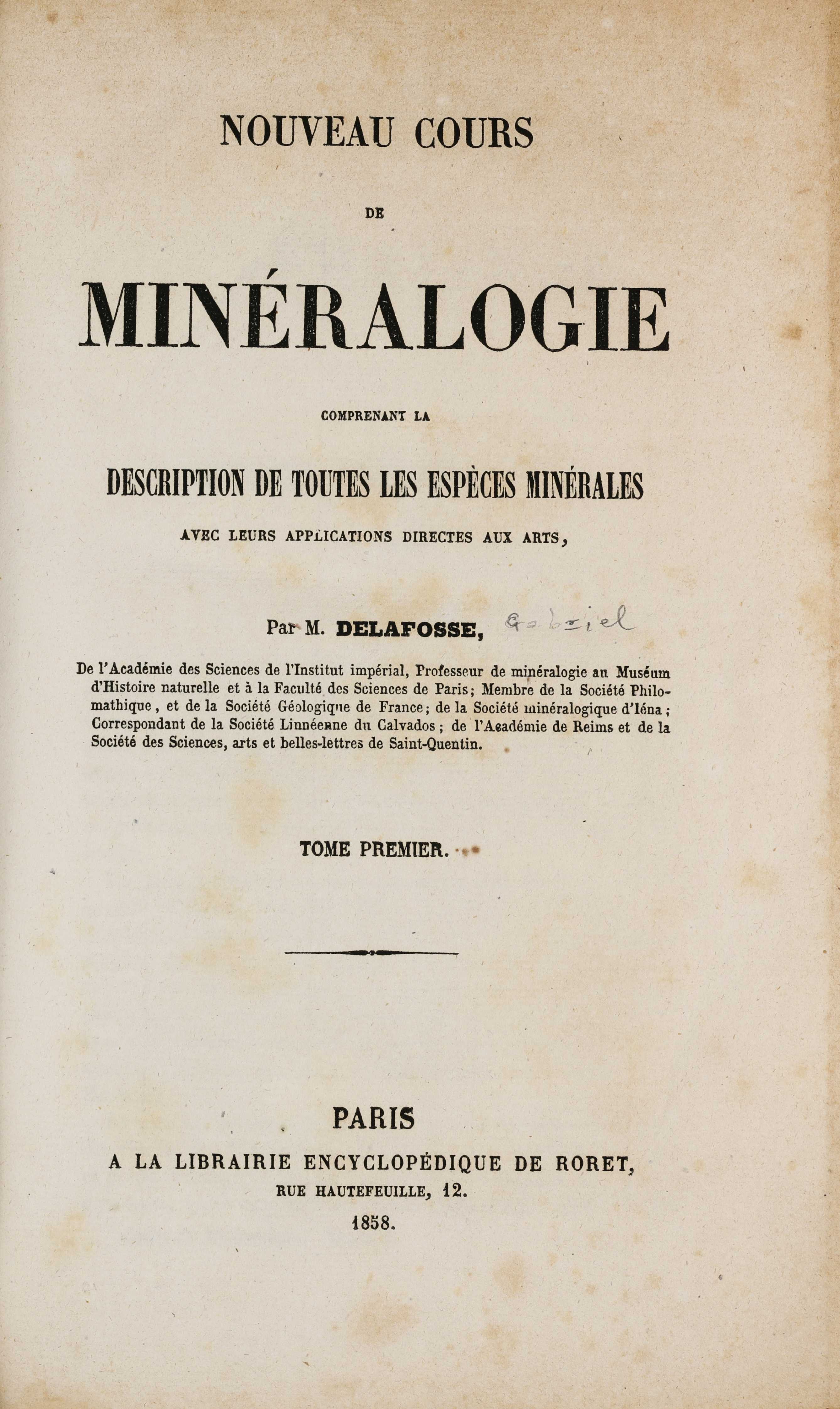
Nouveau Cours De Minéralogie Comprenant La Description De Toutes Les Espèces Minérales Avec Leurs Applications Directes Aux Arts.
DELAFOSSE, Gabriel 1858-1862. Four parts bound in four volumes (three of text and one atlas). 8vo (217 x 140 mm). Text volumes: [4], 546; [2], 486, [2]; [4], 628, 8 pp.; Atlas: [1-5] 6-16, [1] 14-24 pp., 40 double-page lithographed plates of crystal structures. Half-title and title to each volume; vol. I and II bound without final blank; 8 pp. of adverts in vol. III bound at end. Uniformly bound in 20th-century half green calf over marbled boards, spines with 4 raised bands each, silver lettering and tooling in compartments (silver of lettering partially gone). Several pages still uncut and unopened. Text little browned mostly to outer margins, some scattered foxing to text and plates (few pages and plates stronger), vol. I and atlas with light water-staining at lower margin of few gatherings and plates. Provenace: from a private collection of mineralogy books; traces of removed bookplates at pastedowns. Very good, complete and wide-margined set. ---- RARE FIRST EDITION of "Delafosse's most comprehensive work [. . .] drawn from his courses at the Ecole Normale, the Museum [Nationale d'Histoire Naturelle], and the Sorbonne, and published after he attained recognition as a major figure in mineralogy" (DSB). In The New Course of Mineralogy, the author concentrates his text on the practical use of minerals in industry. Gabriel Delafosse (1796-1878) was a French mineralogist, geologist and chemist who worked at the Natural History Museum in Paris and for sometime at the University of Paris. In the field of crystallography, he contributed to development of the idea of unit cells of crystals. Delafosse "considers that their chemical composition should be studied. It thus defines the difference between the 'integral molecule' (molecule) and the 'chemical molecule' (atom) of the crystals. By seeking the provision of the atoms inside the physical molecule, Delafosse is one of the first, in mineralogy, to apply the atomic theory. From this study on the chemical composition of minerals result from many work on the conditions of crystallization. Thus isomorphism and polymorphism with Eilhardt Mitscherlich (1794-1863) will be discovered, then will appear the concepts of dimorphism, homeomorphism, etc." (Schuh). References: Schuh's Annotated Bio-Bibliography, The Mineralogical Record, online resource; DSB 15 & 16 Suppl. I, p.115. - Visit our website to see more images!- $1,687
- $1,687
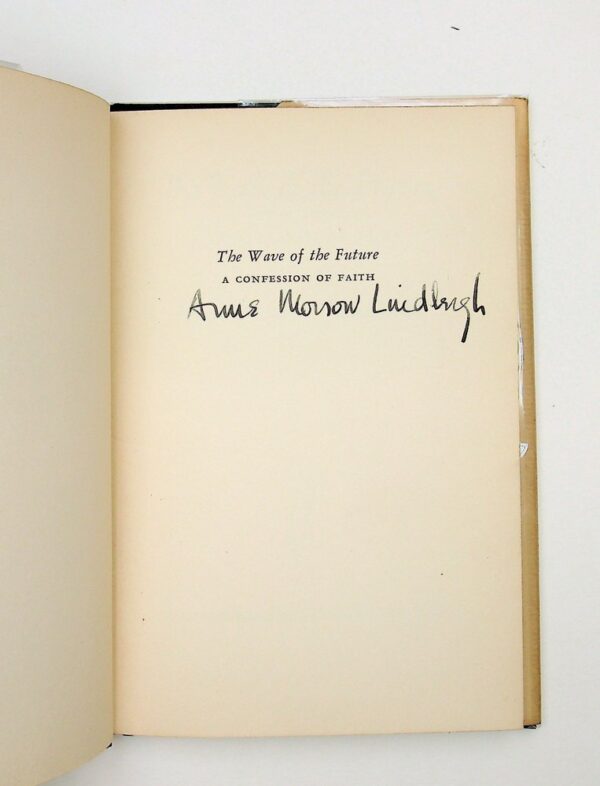
The Wave of the Future – a Confession of Faith
Lindbergh, Anne Morrow Later printing. [4], [1]-41, [1 (blank)] pages. Publisher's dark blue cloth with tan/blue printed dust jacket. SIGNED boldly by Lindbergh on the half title page. Minor wear to the dj extremities, a few spots to the binding. A nice copy. Cloth. The fifth printing in the year of publication, so noted on the copyright page. Dust jacket priced at one dollar. "A positive faith for the future, for those bewildered by the bitter world-events of our time, can be supplied only by one who knows that courage is vital in our daily lives, who believes in the poise of faith against fear. This is a sincere and heartfelt confession." (from the front dust jacket flap) NOTE: dust jacket photograph was taken with a mylar protector on.- $303
- Kuenzig Books | 7 m
- $303

What the Ladybird Heard Next
Donaldson, Julia A first edition, first printing of What the Ladybird Heard Next by Julia Donaldson, illustrated by Lydia Monks, published by Macmillan Children's Books in 2015. A near fine book with very slight bumping to head of the spine.- $125
- John Atkinson Books | 7 m
- $125

Viaggio del cittadino Carlo Mantegazza milanese a S. Domingo nell’anno 1802
Mantegazza, Carlo First edition. In later hard paper. [6] [2] 3-136 p. One of the earliest Italian accounts on Toussaint Louverture and the Haitian Revolution. First edition of this narrative detailing a voyage to the French Caribbean colony of Saint-Domingue in 1802 during the Haitian Revolution, authored by Carlo Mantegazza, an Italian adventurer from Milan. This work is structured as a series of dated letters, beginning on 28 January 1802 in Lyon. Mantegazza's journey includes his departure from Nantes on the Victorine on 20 March 1802. After several entries made at sea, he documents his arrival at Basse-Terre on Guadeloupe on 10 May 1802 before proceeding to Cap-Français in Saint-Domingue later that month. Mantegazza's observations span a wide range of topics: the island's geography, the cultivation of rice, coffee, and sugar, reflections on slavery, the social structure of the island, details about plantations and the slave trade, the colony's economy, and the activities of General François-Dominique Toussaint Louverture (1743-1803), a leading figure in the Haitian Revolution. Notably, this publication is among the earliest Italian accounts of Toussaint Louverture and, to our best knowledge, represents the first firsthand report of the Haitian Revolution in Italian. Sabin 44397. . Later bookplate on the verso of the title page (Monsignor Commendatore Luigi Maggiotti). Light foxing throughout. Otherwise in fine condition.- $1,546
- Földvári Books | 7 m
- $1,546
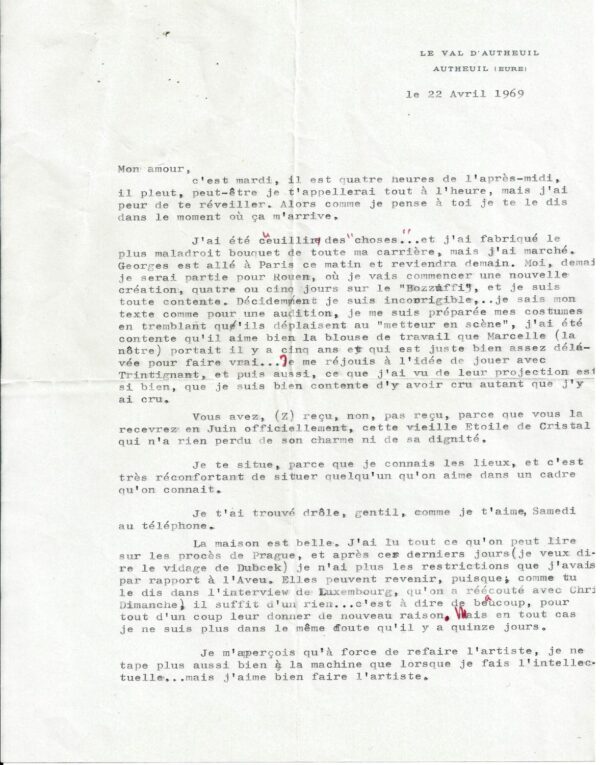
Le 22 Avril 1969
Simone SIGNORET Simone SIGNORET à Yves MONTAND. 2 pages dactylographiées in-4, sur papier gris à en-tête du Val d'Autheuil, Autheuil (Eure), avec signature manuscrite à l'encre rouge. Le 22 Avril 1969 Mon amour, C'est mardi, il est quatre heures de l'après-midi, il pleut, peut-être je t'appellerai tout à l'heure, mais j'ai peur de te réveiller. Alors comme je pense à toi je te le dis dans le moment où ça m'arrive. J'ai été cueillir des « choses » et j'ai fabriqué le plus maladroit bouquet de toute ma carrière, mais j'ai marché. Georges est allé à Paris ce matin et reviendra demain. Moi, demain je serai partie pour Rouen, où je vais commencer une nouvelle création : quatre ou cinq jours sur le « Bozzuffi » [l'Américain] et je suis toute contente. Décidément je suis incorrigible. je sais mon texte comme pour une audition, je me suis préparée mes costumes en tremblant qu'ils déplaisent au « metteur en scène », j'ai être contente qu'il aime bien la blouse de travail que Marcelle (la nôtre) portait il y a cinq ans et qui est juste bien assez délavée pour faire vrai… Je me réjouis à l'idée de jouer avec Trintignant, et puis aussi, ce que j'ai vu de leur projection est si bien, que je suis bien contente d'y avoir cru autant que j'y ai cru. Vous avez, (Z) reçu, non, pas reçu, parce que vous la recevrez en Juin officiellement, cette vieille Etoile de Cristal qui n'a rien perdu de son charme ni de sa dignité. Je te situe, parce que je connais les lieux, et c'est très réconfortant de situer quelqu'un qu'on aime dans un cadre qu'on connait. Je t'ai trouvé drôle, gentil, comme je t'aime, samedi au téléphone». La maison est belle. J'ai lu tout ce qu'on peut lire sur les procès de Prague, et après ces derniers jours (je veux dire le vidage de Dubcek) je n'ai plus les restrictions que j'avais par rapport à « l'Aveu ». Elles peuvent revenir, puisque ; comme tu le dis dans l'interview de Luxembourg, qu'on a réécouté avec Chris, Dimanche, il suffit d'un rien. c'est à dire de beaucoup, pour tout d'un coup leur donner de nouveau raison. Mais en tout cas je ne suis plus dans le même doute qu'il y a quinze jours. Je m'aperçois qu'à force de refaire l'artiste, je ne tape plus aussi bien à la machine que lorsque je fais l'intellectuelle, mais j'aime bien faire l'artiste. Langlois de la Cinémathèque m'a appellée [sic] tout à l'heure pour me prévenir que la Cinémathèque allait me faire un « hommage » pendant dix jours. Pour prendre une contenance j'ai d'abord dit « tu crois pas que ça fait prétentieux ? » et puis finalement je lui ai dit que j'étais bien fière et bien contente. Si je ne travaillais pas ça aurait un petit côté « posthume », mais comme je travaille, je suis. bien fière. et bien contente. un point c'est tout. Peut-être à cause de tout ce que j'ai lu, et relu, (en particulier le dossier de Sartre sur l'affaire Rosenberg qui s'appelle le Chant Interrompu, et dans lequel Aragon cite la phrase d'Eluard. que je nous suis revus tous les deux dans la chambre à Angers… !) peut-être disais-je à cause de tout ça, je mesure à quel point ces vingt années cheminées ensemble, ont été peu communes. Peut-être que tout ce verbiage va tomber à côté, par un de ces matins calmes et Beverlyhillsiens que j'aime autant que toi, mais ça aussi je le comprendrai, parce que je les connais. Allez, hein, allez. je t'aime. XXX Simone. Embrasse les copains [manuscrit à l'encre rouge] 1000 €- $1,124
- Librairie Dutel | 7 m
- $1,124

The Dance of Death at London, Ontario.
REANEY, James and Jack Chambers. Signed and dated 1964 by Reaney. Tall 8vo., orig. pictorial wrappers, 32pp. With illustrations by Jack Chambers. Some browning to spine and perimeter of wrappers but still a near fine copy of an uncommon publication. This is the first publication from Alphabet Press and the blurb on the rear wrapper states that it 'represents a collaboration between an artist and a poet that is rare and unusual. The poet's idea for this chapbook came from an old German book called The Dance of Death at Basle. This "totentanz" book was not the only imetus though, for it was only after seeing some burdocks in an old graveyard at the edge of the city that the book really began to get going.' Reaney was the editor of the literary magazine, Alphabet, and Chambers was a painter whose work was exhibited at the Isaacs Gallery in Toronto.- $206
- David Mason Books | 7 m
- $206

Autograph Letter Signed. Boston, August 26, 1793. To Messrs. Newton, Gordon and Murdock, Madeira, Portugal., hand-carried by Captain Howland.
Vaughan, Charles Quarto, 3 pages plus stampless address leaf. small holes in text from seal opening and heavy ink bleed-through with loss of text. Fair condition overall. 1793 During the "Citizen Genet" affair, President Washington maintains strict American Neutrality in the European wars that followed the French Revolution. "…I am confirmed in my determination of suspending any shipment at present…You have judged too hastily of our Government. The Executive has decidedly avowed a disposition to be neutral and has taken very active measures…to prevent any step that could be construed as a breach of Treaties… Privateers … have offered offences to our navigation that will produce spirited remonstrances from us… with an almost unanimous voice in favor of peace and a perfect neutrality - we can have little fear of a cause for rupture on our part and we look for the same disposition with your Government, whose decided Interest it is to keep on good terms with us…" Written by a prominent Boston merchant to the leading British wine-sellers of Madeira, months after revolutionary France declared war on England and Spain, as President Washington formally proclaimed strict American neutrality. This was made difficult by privateers seizing American commercial vessels on the high seas - with some French privateers commissioned to capture British ships by French diplomat Edmond-Charles ("Citizen") Genet over the heated protests of Washington and Secretary of State Thomas Jefferson. At this tumultuous time, Vaughan could speak with some personal authority of "Executive" Washington's sentiments. His father and grandfather were on close terms with the President, having been guests at Mount Vernon after the Revolutionary War. The younger Vaughan was also knowledgeable about the Naval War that was then harrassing American shipping; in fact, Captain Howland who carried Vaughan's letter across the Atlantic had just arrived in New Bedford with a harrowing tale of his most recent voyage from chaotic Haiti, his ship being stopped seven times by French, Spanish and English privateers, all treating him with "great civility" except for one British privateer who had attempted to seize his ship as a prize, an attempt foiled by Howland's loyal crew. Washington refused to accept all such "prize" claims, ordering that any American ship sailed to an American port by a privateer's prize crew, should be returned to its original owners.- $200
- Michael Brown | 7 m
- $200

Speech of Samuel P. Lyman, on the Opening of the Erie Railroad, Astor House, May 14, 1851.
Lyman, Samuel P. octavo, 16-page pamphlet, original printed paper wrappers, a very good clean copy. Lyman relates the prospects for economic growth along the 425-mile route of the just opened Erie Railroad, connections with railroads and canals and the benefits to trade as a result. He also gives an account of the struggles to build the route giving credit to the politicians whose influence helped the road, including Daniel Webster, who was in attendance, he also cites the engineers and investors who helped make it possible.- $125
- Michael Brown | 7 m
- $125
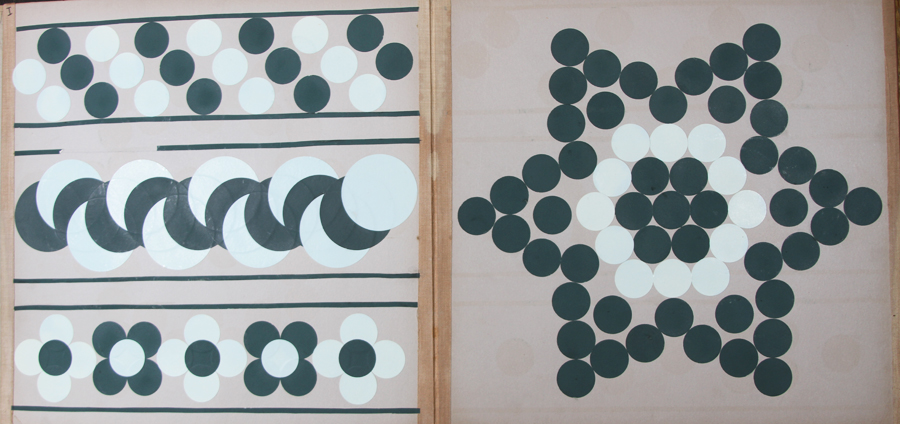
Album of Kindergarten Work – Paper Cutting and Paper Folding
Doyle, Agnes Oblong quarto, undated, likely late 19th early 20th century, 31 examples of paper cutting mounted on cardboard leaves, which fold accordion style into a brown cloth album, with string tie, "Kindergarten Work" stamped in gilt on front board, in very good, clean condition. This album contains the paper cutting and folding work done by Agnes Doyle for two of Froebel's "Occupations" in this case paper cutting and folding. The materials in this occupation were scissors and papers, squares, triangles, and circles of white or colored paper. The papers were first folded and then cut according to either geometric progression or fancy, the pieces subsequently arranged in a design by the child. The child also cut flowers, fruit, animals or any complete form from the paper without folding, and the work subsequently mounted on cardboard. This album is a particularly nice example of its kind. The present album grew out of the series of "gifts" and "occupations" devised by Friedrich Wilhelm Fröbel as part of his Kindergarten system of early childhood education. "Kindergarten has been around so long, and is so thoroughly familiar, that it is natural to assume personal expertise on the subject. But kindergarten for us, and for most of the generations born in this century, is a distortion, a diluted version of what Friedrich Wilhelm Fröbel (1782–1852) originated as a radical and highly spiritual system of abstract design activities developed to teach the recognition and appreciation of natural harmony. Kindergarten has always included singing and dancing, as well as observation of the workings of nature—the growth of plants, the symmetries of crystals and seashells. One's teacher was usually a woman and she led the class in activities that would have been considered play outside the school. But long abandoned, and thus hardly known today, is the practical and philosophical heart of the system—Fröbel's interconnected series of twenty play "gifts" using sticks, colored paper, mosaic tiles, sewing cards, as well as building blocks, drawing equipment, and the gridded tables at which the children sat." – Norman Brosterman, See also: Brosterman, Norman, Inventing Kindergarten (New York: Abrams, 1997)- $500
- Michael Brown | 7 m
- $500
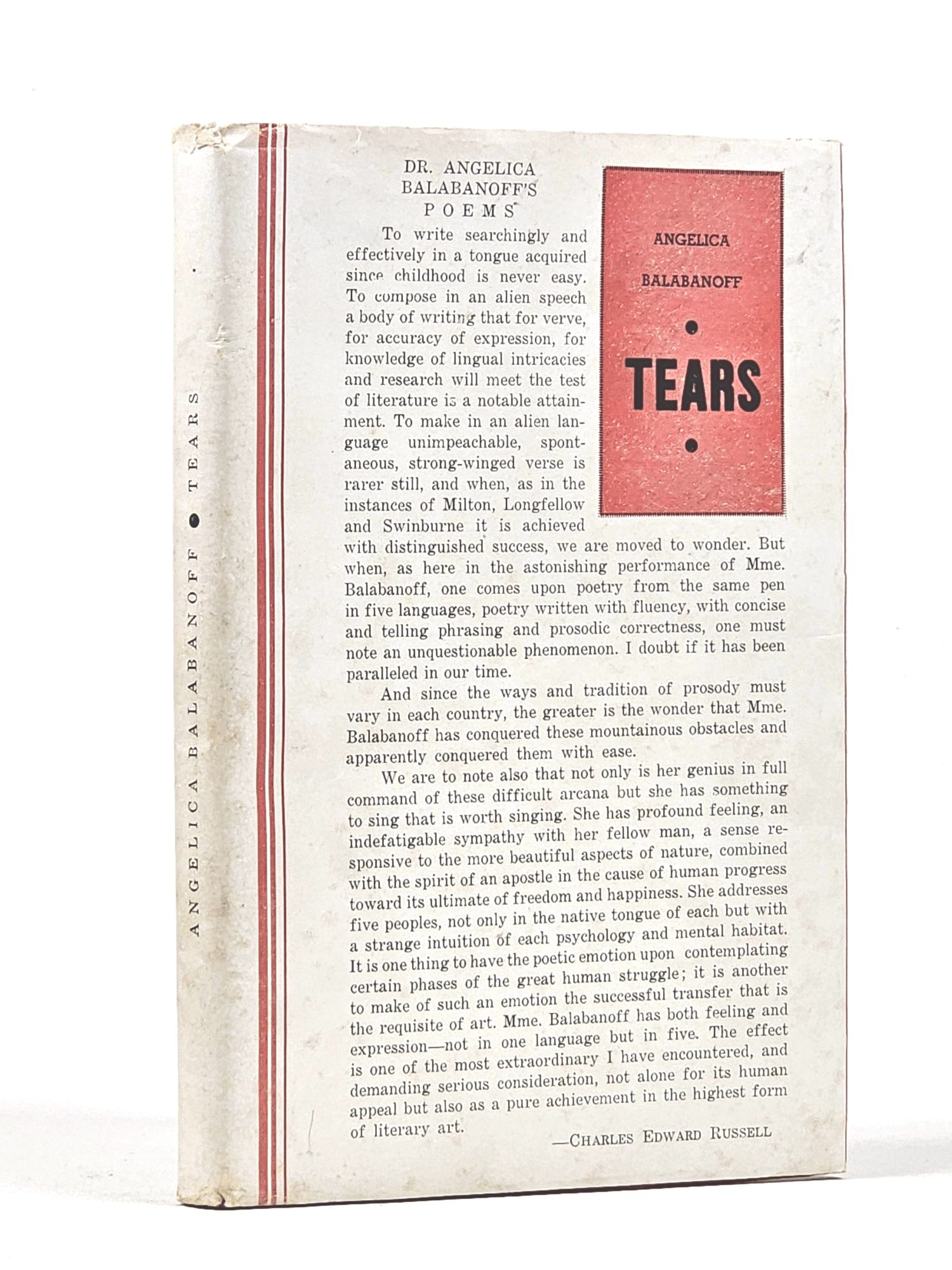
Tears (Signed)
Balabanoff, Angelica (1878-1965) Poems of political struggle, published while Balabanoff was in exile in New York during World War II. She was a Russian-born Italian Jew who had worked with Lenin, Trotsky, and Zinoviev, and with Socialist leaders in Italy before being forced into exile by the rise of Mussolini. Balabanoff has inscribed and signed this copy on a preliminary blank leaf: "For the comrades / O + R Fox / Thanking them for their / warm hospitality / and hoping to meet them / again and again! / W. D.C. 8-27-43 / [signature]." Introduction by Arturo Giovannitti. Dust jacket features lengthy blurbs by Charles Edward Russell and others. Bound in thin, flexible, red velvet-covered boards with upper board titled in gilt, which has darkened. Some shallow bumping to the Yapp edges of covers. Jacket has a few shallow edge wrinkles and light soil. Overall near fine in a near fine dust jacket. Thin velvet-covered boards. Octavo. 159 pages- $173
- Back Creek Books LLC | 8 m
- $173

Decorated leaf from a Book of Hours Manuscript on vellum.
Bible. Psalms. Latin. One vellum leaf, 125 x 180 mm, with text within 80 x 95 mm guidelines. Text in manuscript recto and verso including eight capitals decorated in gold leaf and colors, and six spacers also decorated in blue, red, and gold leaf. Chapter incipit in red.- $350
- $350
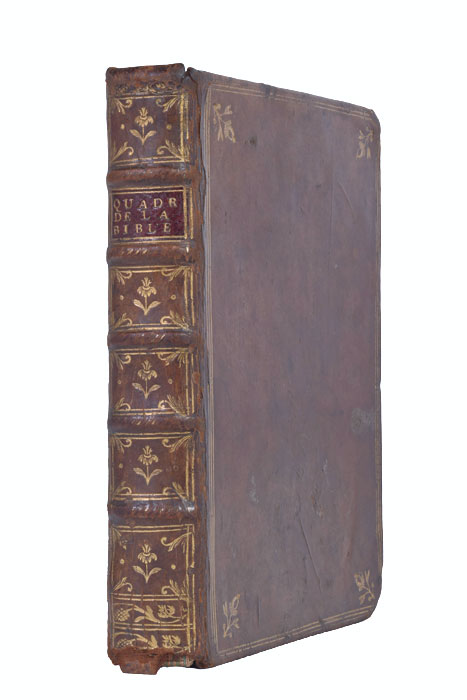
Quadrins Historiques de la Bible. Revuz, et augmentez d’un grand nombre de figures. A Lion, par Jan de Tournes, 1555. RELIÉ AVEC (à la suite): 2). [ FONTAINE (Charles) ]. Figures du Nouveau Testament. A Lion, par Jan de Tournes, 1556.
[ PARADIN (Claude) ]. 2 ouvrages en 1 volume petit in-8. 1). 120ff. 2). (1f.blanc). 52ff. Plein veau, dos à nerfs orné, triple filet doré autour des plats avec fleurons dorés dans les angles (reliure du 18e siècle, coins émoussés). 1). Deuxième édition, en grande partie originale, de ce "pur chef-d'uvre de l'école lyonnaise" (Brun) du livre illustré de la Renaissance, dont l'imprimeur Jean de Tournes et le peintre-dessinateur Bernard Salomon furent les plus célèbres protagonistes. Ornée d'un titre inscrit dans un bel encadrement d'arabesques gravées, et de deux cent trente-et-une gravures sur bois d'après les dessins de Bernard Salomon, cette édition contient trente-trois gravures de plus que la première de 1533. 2). Edition Originale illustrée de quatre-vingt-seize gravures sur bois d'après Bernard Salomon. L'exemplaire de la Morgan library présente, comme le nôtre, les "Quadrins Historiques" de 1555 et les "Figures du Nouveau Testament" de 1556 reliés ensemble. Exemplaire assez joliment relié en veau blond au 18e siècle. Il est court de marges: le couteau du relieur a rogné quelques millimètres des ornements des deux pages de titre ainsi que quelques bandeaux décoratifs et une demi-ligne de texte, en haut de deux pages. Très bon exemplaire par ailleurs. 1). Cartier, Bibliographie des éditions des de Tournes, 292. Brun, Le livre illustré de la Renaissance, 132.- $8,433
- Librería Comellas | 8 m
- $8,433

Harper s Weekly
Five bound volumes of the complete issues for the years 1861-1865. Contents in excellent condition. The bindings show some light to moderate wear to the exterior boards but remain sturdy and tight. Harper's Weekly was the most widely read journal in the United States throughout the period of the Civil War. So as not to upset its wide readership in The South, Harper's took a moderate editorial position on the issue of slavery prior to the outbreak of the war. The Weekly had supported the candidacy of Stephen A. Douglas in the 1860 presidential campaign against Abraham Lincoln, but as the American Civil War broke out, it fully supported Lincoln and the Union. A July 1863 article on the escaped slave Gordon included a photograph of his back, severely scarred from whippings; this provided many readers in the North their first visual evidence of the brutality of slavery. The photograph inspired many free blacks in the North to enlist. Some of the most important articles and illustrations of the time were Harper's reporting on the war. Besides renderings by Homer and Nast, the magazine also published illustrations by Theodore R. Davis, Henry Mosley, and the brothers Alfred and William Ward. Sold as a set - $12,500- $12,500
- Quaker Hill Books | 8 m
- $12,500
![Ezhednevnyia zapiski v Londone [A Daily London Notebook]](https://rarebookinsider.com/wp-content/uploads/2024/07/31936673019-600x866.jpg)
Ezhednevnyia zapiski v Londone [A Daily London Notebook]
SVININ, Pavel Petrovich The first Russian book on the UK and its capital, and the start of Russian anglomania --- First edition of these rich and entertaining notes, including great comments on Londoners (vs Parisians especially!). Rare: Apparently only one copy in the UK (British Library). WorldCat locates 5 other copies:NYPL (incomplete), Columbia, Cornell, Berkeley, and Library of Congress but the latter is in fact a photocopy 'made by the British Museum from another issue of the same year'. Interestingly, the title-page in the British Library copy is a completely different (later?) setting, with a quotation from Rousseau rather than Chateaubriand. We could also locate three holdings in Russian libraries, and only two copies at Western auctions in recent decades. Artist, collector, writer, an acquaintance of Pushkin and Gogol and the founder and editor of the famous journal Otechestvennye zapiski [Fatherland Notes], Svinin (17871839) published the present account of London life in the wake of his earlier Sketches of Moscow and St Petersburg (Philadelphia,1813; his first book), and Opyt zhivopisnago puteshestviia po Severnoi Amerike ('A picturesque voyage across North America: an essay', St Petersburg, 1815). A member of the first Russian diplomatic mission to the US (1811-13), Svinin is considered "one of the best known and most influential observers of life in the United States" (Bolkhovitinov, our translation here and below) for his work about America. In the summer of 1813, Svinin served at the headquarters of the Russian army in Germany and was repeatedly sent to London with dispatches. One of his tasks was to deliver a pension from tsar Aleksandr I to the widow of General Moreau, Napoleon's main rival, whom Svinin met in America. Svinin's observations of London during this trip begin, as a sort of introduction with separate pagination, with amusing comparisons between London and Paris. He then focuses on various elements of the city (such as post offices and roads), with chapters on the Congreve rockets at Woolwich, Greenwich Hospital, the astronomer William Herschel, the British Museum (and its Library: 'the best in Europe'), London's theatres, Newgate Prison, Kew and Windsor. The final chapter offers an account of Aleksandr I's visit in 1814. Among a great variety of subject matters, Svinin pays also attention to the "strangeness of English morality": "I observe also that the very laws of England and the charitable institutions give some excuse for the debauchery of the girls. Nothing can be stranger and more unjust than the law on this subject, which is very strictly enforced in England and America! A girl's oath is preferable to all man's oaths and is more respected, therefore, if a girl swears on the Gospel that so-and-so caused her pregnancy, regardless of all denials and arguments, he must either marry her or provide a known sum for raising the child". He also discusses theft issues on the streets: "The beggars in London constitute a class of artisans unknown anywhere else, for sanctimony here is not a sign of poverty, but a kind of industry [.] The swindlers have their own Academy in this quarter, where young candidates are trained - to unload other people's pockets, according to some systematic rules". This is the first extensive Russian work about London, and the UK in general, and the first Russian book focusing exclusively on the subject. The only works published before Svinin's observations were parts of larger travel accounts, and were few. The first may well be Nikita Demidov's Zhurnal puteshestviia. [Diary of a Travel.] in 1786 with only about 25 pp. on London and parts of the UK; then came Nikolai Karamzin's Pisma russkogo puteshestvennika [Letters of a Russian Traveller] (Moskovskii zhurnal [Moscow Journal], 1791-92), which included notes about England. His "Puteshestvie v London" ["Trip to London"] an additional fragment from The Letters was then published in his almanack Aglaia in 1794. And lastly Petr Makarov's article "Rossiianin v Londone, ili pisma k druziam moim" ["A Russian in London, or Letters to my Friends"] was included in Karamzin's Vestnik Evropy [Messenger of Europe] in 1804. Several fragments of Svinin's work were published in Syn Otechestva [Son of the Fatherland] magazine in 1815. This complete edition of 1817 was followed by multiple other travel accounts of England as the 1820s saw a new surge of anglomania among the nobility: "the aristocrats were fascinated by the English language and literature, borrowed the principles of the household, and most of all admired the polity of the distant island country" (Grigorieva). Provenance: Duke Vsevolod Dolgorukii (ownership inscription to lower pastedown; most likely Vsevolod Alekseevich Dolgorukii (also Dolgorukov, 1845-1912) - writer and publisher, author of a celebrated travel guide to Siberia (1895). Without substantial financial means, Dolgorukov was involved in various small scams individually and as part of The Jack of Hearts Club (that mainly consisted of Russian nobility). He was imprisoned several times and eventually was exiled to Tomsk. There he resumed his literary work and was an editor of a number of magazines and actively published in Tomsk, Moscow and St. Petersburg periodicals) Physical description:Duodecimo (16.6 × 10.6 cm) in half-sheets. Title, dedication leaf, t.o.c. leaf, V and 249 pp. Contemporary half roan over marbled boards, flat spine with gilt lettering and gilt fleurons in compartments. Condition:Binding a bit worn but solid, extremities rubbed, corners bumped, free endpapers sometime removed, scribbles to pastedowns and final blank page; old waterstain to lower portion of the text block, some marginal staining to lower corner of the first 60 pages or so, occasional finger-soiling in places. Bibliography:Sm.-Sok. I, p. 424 (added by the editor) but absent from his collection. Bolkhovitinov N. N., "Obraz Ameriki v Rossii" // Amerikanskaia tsivilizatsiia kak istoricheskii fenomen. Vospriiat- $6,295
- PY Rare Books | 8 m
- $6,295
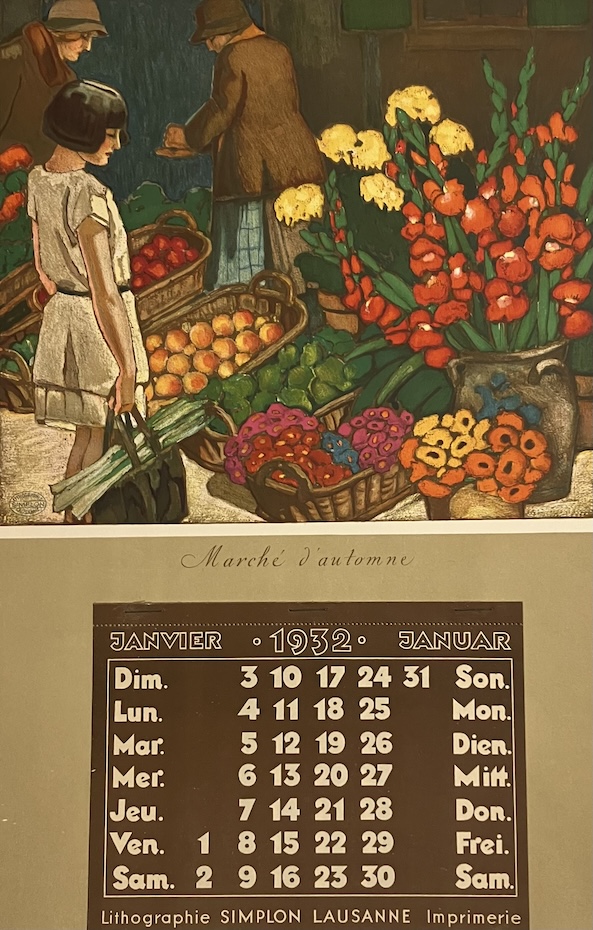
Marché d’automne *
[Calendrier] Anonyme : Carton 41 x 28, premier plat imprimé polychrome, bien complet des mois. Les maîtres imprimeurs Trüb venu d'Arau s'installer à Lausanne sous le nom de la lithographie du Simplon, avant que Roth & Sauter n'enfante le Verseau, faisant déjà des calendrier d'une belle tenue? > En cas de problème de commande, veuillez nous contacter par notre page d'accueil / If you have any problems with your order please contact us via our homepage- $128
- OH 7e CIEL | 8 m
- $128
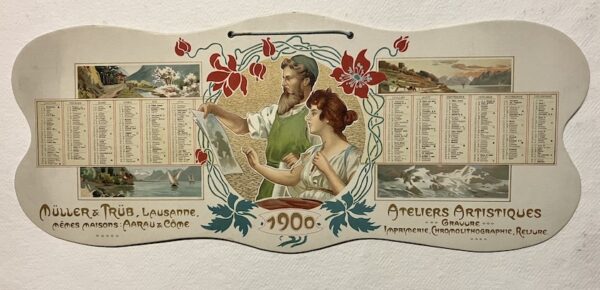
Sans titre *
[Calendrier] Anonyme : Carton 20 x 45, premier plat imprimé polychrome. Les maîtres imprimeurs Trüb venu d'Arau s'installeront à Lausanne sous le nom de la lithographie du Simplon, avant que Roth & Sauter n'enfante le Verseau, faisant déjà des calendrier d'une belle tenue? L'un des plus anciens, cette firme ayant été créée en 1890. > En cas de problème de commande, veuillez nous contacter par notre page d'accueil / If you have any problems with your order please contact us via our homepage- $128
- OH 7e CIEL | 8 m
- $128

Le Soleil Au Signe du Lyon d’ou quelques paralleles sont tirez, avec les tres-Chrestien, tres-Iuste, & tres-Victorieux Monarque Louys XIII. Roy de France & de Navarre, en son Entrée triomphante dans sa Ville de Lyon. Ensemble Un sommaire recit de tout ce qui s’est passé de remarquable en ladite Entrée de sa Majesté, & de la plus Illustre Princesse de la terre, Anne d’Austriche, Royne de France & de Navarre, dans ladite Ville de Lyon le 11. Decembre 1622
SPLENDID CEREMONIES. GRAND ENTRIES bound with Reception de tres-chrestien, tres-iuste, et tres-victorieux monarque Louys XIII. Roy de France & de Navarre, premier Comte & Chanoine de l'Eglise de Lyon: et De Tres-chrestienne, Tres-auguste, & Tres-vertueuse Royne Anne d'Austriche: Par Messieurs les Doyen, Chanoines, & Comtes de Lyon, en leur Cloistre & Eglise, le XI. Decembre, M. D. XXII. Lyon: Par Jaques Roussin, 1623 FIRST EDITION OF BOTH WORKS Folio in 4s: 29 x 20 cm. Soleil: Ï1(=A1?) *4 Î'4(-Î'1) B-R4 (R3 blank) S-X4 Y6 [$3 signed; -*2, *3, D1, G1, H2, K1, L1, M3, P1]. 94 leaves, pp. [10] (title printed in red-and black, blank, 4pp. dedication, 3pp. to the reader, imprimatur) 3-180. [=x, 178] With 12 engraved plates (11 integral with the text), of which 1 is folding (not integral). "Reception": A-G4 H6 [$3 signed; -A1, E2, E3]. 34 leaves, pp. 1-2 (title, blank) 3-67, blank. With 7 engraved plates (3 integral with the text), of which 4 are folding (not integral). Collated complete against the BnF copies. Bound in contemporary parchment (mild soiling and wear, a little rumpled.) On the spine, title in ink manuscript ("L'entrée/ De Louys/ XIII a/ Lione"). Text in fine condition with some very mild toning, occasional spotting, and a few minor stains. A few lvs. (C1/4 second work) lightly browned. A few clean tears repaired, no loss. Small marginal tears to a few lvs., far from the text. Bookplate of Paul and Marianne Gourary to the front paste-down. Ownership signature of "d. Rubto Galilei" to the front paste-down. Two works describing and illustrating the entry of Louis XIII (1601-1643, r. 1610) and his Queen consort Anne of Austria (1601-1666, m. 1615) into Lyon on 11 December 1622. Richly illustrated with engravings by Charles Audran, G. Autgers, Pierre Faber, Grégoire Huret, Philippe de Malley and David van Velchem. This royal tour marked the end of the first Huguenot rebellion, which was resolved by the Treaty of Montpellier, signed 18 October 1622. With scarcely six weeks to prepare, Lyon welcomed the triumphant king and queen - the titles' emphasis (very Christian, very just, very victorious) is telling - and celebrated their reign with pomp and spectacle. Louis XIII is here compared to the sun, a title more usually applied to his son Louis XIV, le roi soleil. The royal entry at Lyon was one of a number of celebratory stops made by the royal couple on the way from Montpellier (where the king had just signed the treaty.) Other regal celebrations were held in Arles (October 30, 1622), Aix (November 3 and 10, 1622), Marseille (November 7, 1622) and Avignon (November 16, 1622). These two related two works describe the entry, the monuments, ceremonies, and festivities. The "Sun in the sign of Lyon" describes the different monuments, composed of triumphal arches, columns, fountains, etc. erected for the occasion. It is illustrated with a vignette on the title with the arms of Lyon, drawn and engraved by Pierre Faber, and with 12 figures, including 11 full page and one folded out of text, by Faber, D. de Mallery, Grégoire Huret, Van Velkhem and G. Autguere; they represent the different monuments described in the work. One of the engravings shows the magnificent fireworks display over the river Saône. The present volume belonged to Ruberto Galilei (Roberto, born 1595), a Lyon-based cousin (fifth, once removed; nevertheless Favaro describes him as "sinceramente affezionato a Galileo") of the renowned scientist Galileo Galilei (1564-1642). Ruberto acted as an intermediary for Galileo's foreign correspondence - with Diodati, Peiresc, Mersenne et al. - after his inquisitorial trial in 1633. The cousins also corresponded, especially concerning the movement and publication of books. Ruberto moved from Florence to Lyon as a young man, and so possibly witnessed this joyeuse entrée. [1] An earlier issue of the Reception with a 1622 date (surely a nicety rather than a sign that the work was conceived and published in 20 days) is recorded, but is otherwise identical. [2] Fa- $15,000
- $15,000
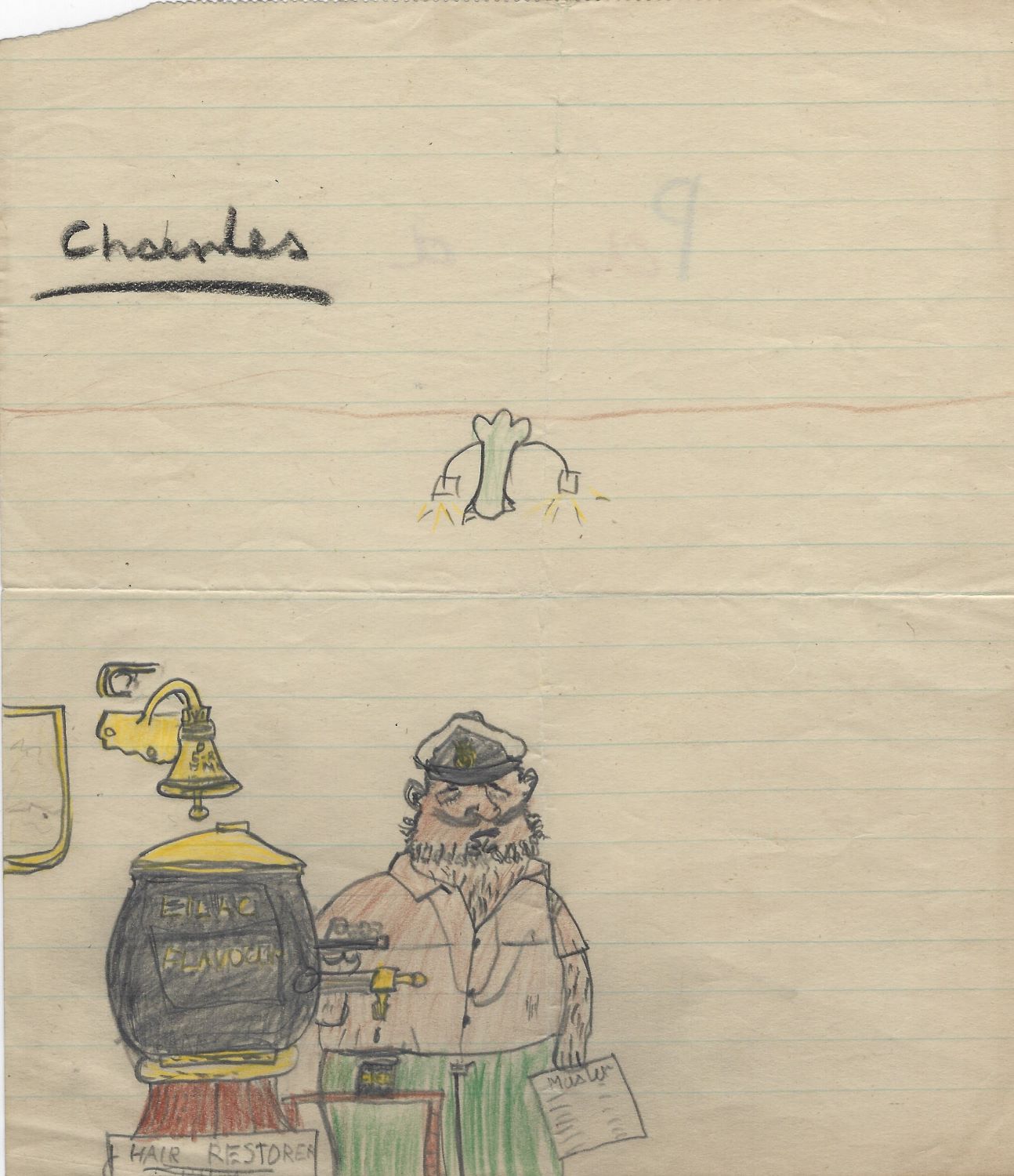
Extraordinary signed caricature of his father by the young Charles
King Charles III Charles III, King (1948 – ) A very interesting and amusing original drawing by King Charles III, accomplished as a child, circa 1957. The young prince has drawn a detailed image, using various colour pencils, of a bearded man wearing a captain's peaked cap, pulling a pint of bear and holding a piece of paper on which the word 'Master' is written. Beneath the tankard of beer is the label 'Hair Restorer'. Charles has signed his name boldly. at the top of the 7.5″ X 8.5″ sheet. To the reverse, he has written 'Papa' in different colour pencils, indicating that the drawing was more than likely gifted to his father. Prince Philip did indeed sport a beard in 1957, and travelled the world on HMY Brittania. A terrific son-to-father joke encapsulated on a page. A horizontal central fold, otherwise in very fine condition. An extraordinary item.- $11,293
- $11,293

A great Fleming letter – the author gets influence for a Bond plotline!
Ian Fleming Fleming, Ian (1908 – 1964) 'James Bond must emulate that exploit' A fine typed letter signed by Ian Fleming ('Yours ever, Ian'), Kemsley House letterhead, May 2nd 1957. Fleming writes to fellow author R. W. Thompson. In full: 'What an extraordinary kind thought to have written such a warm and splendid letter. I couldn't have been more pleased, although there is surely a touch of the old Thompson hyperbole in your praise. Anyway it was intoxicating stuff to find on my same old desk in W.C.l. on a dull Thursday morning. I do hope all goes well with you and that being a writer in your own time and not a hireling has proved the right choice. I am sure it was. Your wine is far too new for the aged fiascos of Fleet Street. I shall never forget that bed of roses story about you — in Belgium I think it was — at the end of the war. One day James Bond must emulate that exploit. Again a thousand thanks for the wonderful letter.' Fleming adds the salutation in his own hand: 'My dear Tommy'. In fine condition, with a short tear, and paper loss, to the upper right corner. A warm letter of reply from Fleming, who, true to his word, would revisit 'that bed of roses story' in From A View To A Kill, one of five short stories published in the 1960 book For Your Eyes Only. The referenced passages read as follows: '…there was a low mound, perhaps a tumulus, covered with brier roses…' (p. 34), '…inside the mound, deep down in the earth, was the most professional spy unit that had ever been devised…a shiver of excitement and anticipation, almost of fear ran down Bond's spine…' (p. 38), and 'Instead of the periscope, a rose-stalk aerial would rise up from the bush… deep down under the earth off would go the high-speed cipher' (p. 40). Fleming letters referencing his iconic James Bond character are especially scarce, with this particular example all the more desirable given its creative connection to a well-known 007 short story. Reginald William Thompson (1904-1977) was an Army officer, journalist, author and friend of Ian Fleming. He served in World War II and was promoted to Captain before being transferred to the Intelligence Corps for training. After demobilization, Thompson joined the Kemsley Newspaper Group, attending and reporting on the Nuremberg trials. He travelled extensively as a war correspondent for the Sunday Times. In 1951, Thompson settled in Suffolk to write full-time on military subjects.- $9,964
- $9,964
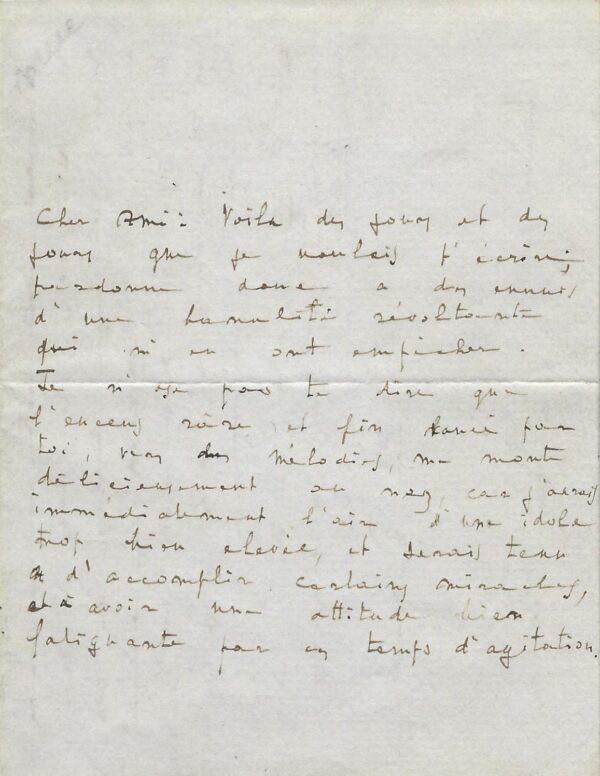
A fine, early content autograph letter signed by Debussy
Claude Debussy Debussy, Claude (1862 – 1918) 'I haven't the least intention of disconcerting my contemporaries with insomnious harmonies.' A fine three-page autograph letter signed by Claude Debussy ('Cl. Debussy'). Written on October 5th 1890 (according to postal stamp on accompanying envelope) in fountain pen ink on a single folded sheet of paper, and addressed to his friend, the composer Raymond Bonheur (1861 – 1939). Debussy opens with a flourish: 'I've wanted to write to you for days and days; some annoyances of revolting banality have prevented me from doing so. I don't dare tell you that the rare and fine incense launched by you over the melodies rises deliciously to my nostrils, for then I would immediately have to behave like an exalted idol and be obliged to accomplish miracles and assume a posture that is pretty tiring in an age of upheaval.' He goes on, 'Besides, I haven't the least intention of disconcerting my contemporaries with insomnious harmonies. I simply want the assent of people like yourself, who are disinterested in easy programmes and are truly willing to believe in music devoid of impure mixtures. Why look first at the label, and put oneself on the level of things that are sold in the bazaars? Let us make music that contains our whole lives and not merely small corners of it fit only for those who gape and engage in small talk and who never create it [he adds an asterisk, adding a comment below, '*And indeed for those who do create it!'] and that way we will not get in the way of literature or philosophy. With that, I shall expect you one of these days, and am yours very cordially and amicably, Cl. Debussy'. In very fine condition, and together with the original hand-addressed envelope. An interesting and early letter from the composer on the cusp of a new style (a style later known as 'impressionism'), written as it is during a period of flux and inspiration. An ardent follower of Wagner in the 1890s, Debussy had recently concluded that to imitate his style would not be the way forward; he famously described the German composer as 'a beautiful sunset that was mistaken for a dawn'. In 1889, he had first heard Gamelan music at the Paris Exposition, and his friendship with Satie began in 1890; in Satie, he found a kindred spirit. Debussy's subsequent output in the 1890s included celebrated works such as Pelleas et Mellisande, his String Quartet, Prélude à l'après-midi d'un faune and many important piano works; of particular note is his piano piece Rêverie, written in 1890, which employs impressionistic techniques accompanied by late romantic harmony, creating a dreamlike and ambiguous musical landscape — a style he would carry forward into some of his most important works of the period.- $4,982
- $4,982

A fine content signed letter by Mandela
Nelson Mandela Mandela, Nelson (1918 – 2013) 'A younger generation… guiding the country towards a secure and prosperous future' An excellent typed letter signed by Nelson Mandela ('N. Mandela'), on his personal letterhead, April 17th 2004. A lengthy letter to Dr. Ivan May. In full: 'There could have been no more appropriate way for South Africans to celebrate the first decade of democracy than going to the polls in this period. Nothing else symbolised the birth of our non-racial democracy so vividly as those wonderful election days in April 1994. The nation came together in the physical act of voting on those days; it is proper that we marked a decade in the life of democratic South Africa by once more coming out voting for our national and provincial legislatures.' 'We had many challenges and obstacles in our national life over this past decade and the problems ahead remain large and daunting. Too many people in our country are still suffering the hardships and deprivations of poverty. One of the root causes of that poverty is the absence of jobs; nothing can be more of an assault on a person's dignity than the inability to find work and gainful employment. Accompanying poverty are myriads of social ills — illiteracy, homelessness, exposure to preventable diseases, general penury and social vulnerability. And the threat of HIV/AIDS looms large in virtually all aspects of our national life.' 'What we can say, though, is that we now have the weapon and the protection of democracy to face and tackle those problems and challenges. The simplest, but therefore also most fundamental, gain of our democracy is that the people govern. There may be shortcomings in delivery; government departments and officials may in some cases be under-performing; certain interest groups may feel that they are not sufficiently catered for; there are certainly many areas of legitimate and valid complaint and dissatisfaction. All of this, however, is played out, contested, debated and accounted for within the secure framework of a multi-party pluralist democracy.' 'Because of our democracy—non-racial, non-sexist, accommodating of diversity—we have managed over this decade to cement the unity of our nation. Whatever differences we may have and tensions that may exist, our democratic constitutional order is not threatened. We are solidly one nation, united in our diversity, held together by our common commitment to the constitution. We have indeed put our racially divided past firmly behind us and face the future with the confidence of a united, non-racial, democratic country.' 'That future lies in the hands of people and it has been a particular source of satisfaction to observe, especially over these last five years, a younger generation of leaders guiding the country towards a secure and prosperous future. President Thabo Mbeki is a shining and inspiring example of this. His firm leadership and clear vision had manifested not only in the remarkable progress South Africa has made, but also in continental and international affairs. The steady regeneration of Africa and the regard with which South Africa is held internationally are in no small measure due to his work and efforts.' 'The growth, consolidation and sustained health of our democracy are the responsibilities not only of leaders, but also of each and every citizen. We may not take our liberty and our democracy for granted. Too many people in all walks of life and over many years and decades suffered and sacrificed for its achievement. The almost miraculous triumph of reason and compassion over prejudice and fear at the time of our peaceful transition is too precious.' 'Every political party and organisation has a responsibility to keep our democracy alive, our people united and our country progressing towards peace and prosperity. Every individual in every sector of society has the responsibility to remain a caring South African, never indifferent to the affairs and well-being of our c- $1,993
- $1,993

Something About Eve
James Branch Cabell New York, Robert M. McBride, 1929. First edition, first impression. Hardback. A very good copy. Fantastic illustrations by Pape. Some edge wear to the jacket, a few short tears and nicks. Some tanning to the spine, and a little rubbing. Some offsetting to the tissue guards from the illustrations. Illustrations by Frank C. Pape [11399, Hyraxia Books].- $133
- Hyraxia Books | 8 m
- $133
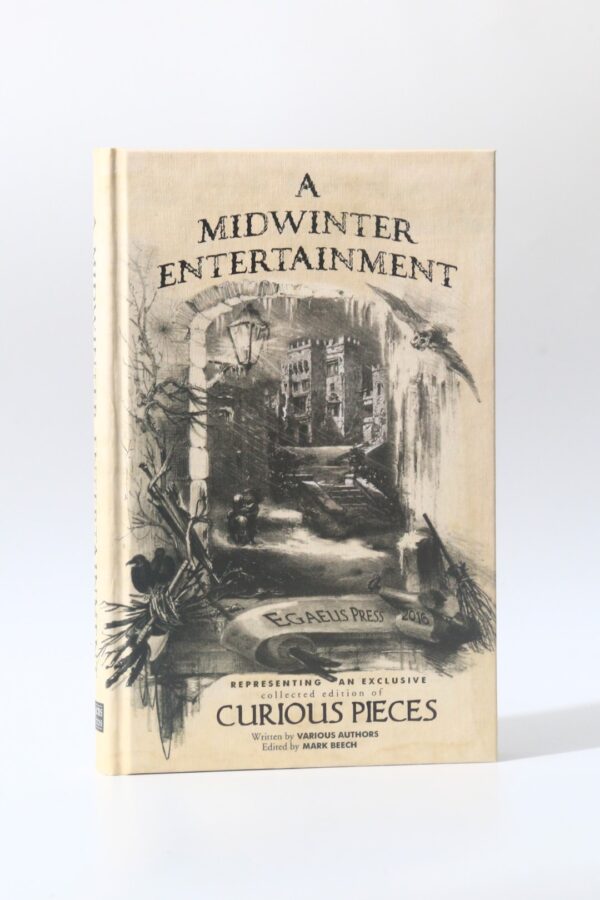
A Midwinter Entertainment: Representing an Exclusive Collected Edition of Curious Pieces
Mark Beech [ed] Shaftesbury, Egaeus Press, 2016. First edition, first impression. Hardback. A fine copy. Collects 21 short tales. One of 400 copies. A lovely production. [11502, Hyraxia Books].- $200
- Hyraxia Books | 8 m
- $200
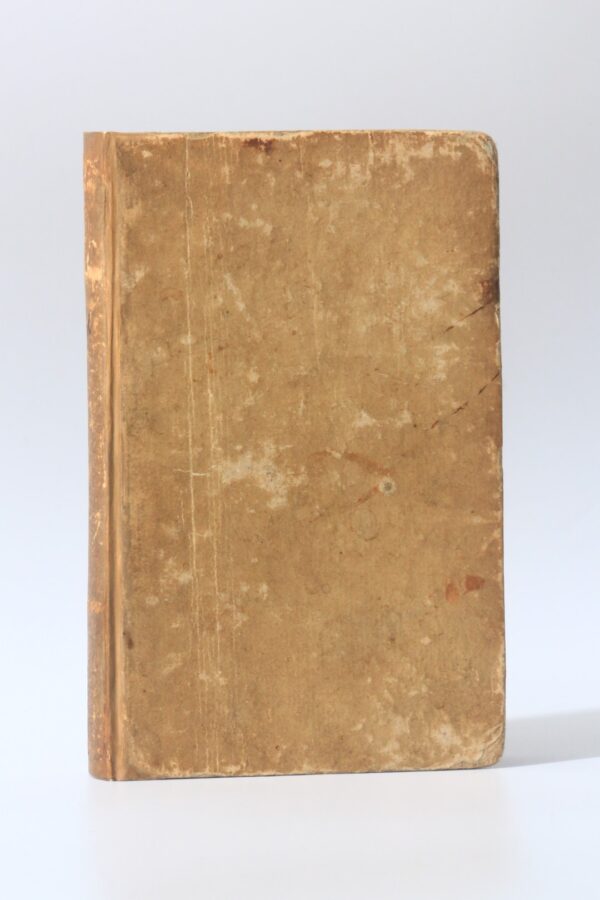
Nicolai Klimii iter subterraneum, novam telluris theoriam ac historiam quintae monarchiae adhuc nobis incognitae exhibens e bibliotheca B. Abelini.
Ludwig Holberg Copenhagen & Leipzig, Jacob Preuss, 1741. First edition, first impression. Hardback. A very good copy. An early classic of underworld science fiction by the father of modern Danish-Norwegian literature. This novel was a major inspiration for Verne, and the first work of fiction to use Halley's theory that planets comprise concentric spheres surrounding a small central sun. Set in the year 1665, the story is told by Niels Klim, who comes back to his native town Bergen after receiving his degree from the University of Copenhagen. While climbing a mountain with a group of friends, he falls into a pit to emerge - after fifteen minutes - in the hollow interior of the Earth. This space is a small cosmos with planets orbiting around a miniature sun. After floating for a while, he eventually lands on a planet named Nazar, in the kingdom of Potu (which echoes "utopia" spelled backwards), and discovers a species of intelligent anthropomorphic tree-men. Holberg's work "blends satire with a fantastic voyage and breathes the spirit of the eighteenth century. Other than its Latin language and passages of verse and prose adapted from classical authors, this novel is entirely modern in spirit. Its description of travel to exotic lands reminds one of his near-contemporary Jonathan Swift's Gulliver's Travels (1726), but with far more wit and humour. Rebacked with original spine laid down, engraved frontis and three smaller plates. Ownership inscriptions. Extremities and surfaces rubbed and worn, some light foxing and a couple of neat repairs to leaves. A nice copy. [11439, Hyraxia Books].- $2,331
- Hyraxia Books | 8 m
- $2,331

TING PA 2
Maclise, Angus & Francis Brooks (eds.), Bill Barker, "Mongolian," Akis Vostanis, Karma Jimba Tzammo, Balakrishna Sama, Katie McDonald, Petra Vogt, T. V. Kapali Sastry, Ira Cohen & Karma Samde Drolma Folio (18 1/4 inches). [16] pp., including numerous woodblock illustrations (printed variously in black and red) plus 1 full-page woodblock print tipped in. In original pictorial wrappers, all on handmade rice paper. Small closed tears at head of front wrapper, light discoloration from original paste affixing large print, else fine. Numbered 102 of 150 copies. The second of three issues of TING PA, one of the early publications of the circle of American and European expatriate writers and artists living in Kathmandu during the 1970s. The woodblock illustrations include Himalayan and East Asian subjects, chiefly from religious traditions, as well as images drawn from the Rider-Waite Tarot.- $1,750
- $1,750
![DARK REFLECTIONS AND SOULDIERS [with:] DISCOVERY](https://rarebookinsider.com/wp-content/uploads/2024/07/31495271886-1.jpg)
DARK REFLECTIONS AND SOULDIERS [with:] DISCOVERY, REVOLUTION & UNDERSTANDING [and:] SECOND THE EMOTION
Fulani, Richard [3] volumes. 35; [4],31; 41,[1] pp. plus author's portrait and biography on recto of rear wrapper of third volume. Original stiff printed wrappers, stapled. Wrappers lightly worn and rubbed, else fine. The first three books of poetry by Richard Fulani, with covers printed, respectively, the pan-African colors of green, yellow, and red. The trilogy begins with Fulani's early poems, composed between 1968 and 1971, with the first part, DARK REFLECTIONS, considering on the breakthrough of new consciousness in the wake of the assassination of Dr. Martin Luther King, Jr., and the second part, SOULDIERS, being a tribute to contemporary African American leaders, "a few of the millions who have made it possible for us to be able to say such things as 'Black is Beautiful' and 'I'm Black and I'm Proud.'" DISCOVERY, REVOLUTION & UNDERSTANDING contains poems "dedicated to the 'endarkenment' needed to see through the blinding, white light," and SECOND THE EMOTION "is a book of feeling," dedicated to "[l]ove, in its broadest sense."- $120
- $120

THE NORTHERN MINES: Factual Narratives of the Counties of Nevada, Placer, Sierra, Yuba, and Portions of Plumas and Butte.
Kinyon, Edmund. Original green cloth with gilt title, octavo, [14], 1-167, [5] pp. illustrations from photographs, folding map at rear. Signed by the author on blank leaf facing title page. Author was a Grass Valley journalist and historian of the Gold Rush. Lght wear to covers but overall very good- $100
- Chanticleer Books | 8 m
- $100
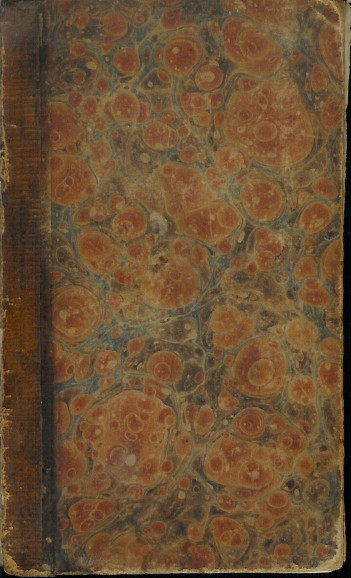
CONVERSATIONS ON THE SANDWICH ISLANDS MISSION. “By a Lady.” Revised by the Publishing Committee.
[Tuttle, Sarah]. 12mo, marbled boards, 216 pp., engraved frontispiece. Rare in commerce. OCLC/World Cat locates 12 copies. Forbes Hawaiian National Bibliography #822. A slightly shorter first edition was published in 1829. Complete but poor. Boards detached but present, spine perished, first gathering loose, first few pages detached, brown stain to last 25 pages (not obscuring text), scattered faint stains to text.- $150
- Chanticleer Books | 8 m
- $150
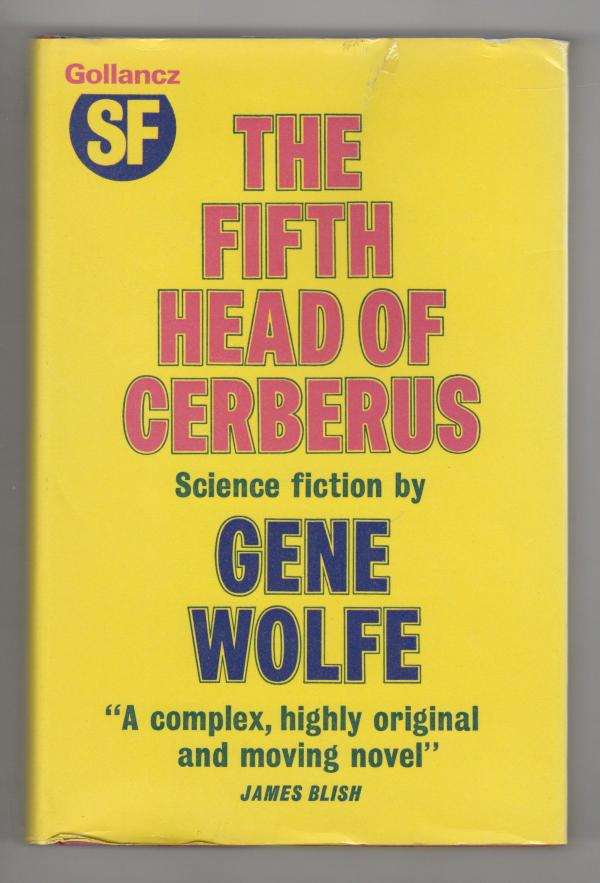
The Fifth Head of Cerberus by Gene Wolfe (First UK Edition) File Copy
Gene Wolfe The Fifth Head of Cerberus by Gene Wolfe (First UK Edition) File Copy A tight bright unread copy with bumped upper corner. "Archive Copy" stamp to title page. A bright dust jacket with a half-inch scrape to upper cover and rubbed corner tip. Not price-clipped. Not price-clipped. Publisher's File Copy. First UK Edition. Three novellas.- $100
- Heartwood Books and Art | 8 m
- $100

The Fifth Head of Cerberus by Gene Wolfe (First UK Edition) File Copy
Gene Wolfe The Fifth Head of Cerberus by Gene Wolfe (First UK Edition) File Copy A tight bright unread copy with bumped upper corner. "Archive Copy" stamp to title page. A bright dust jacket with a half-inch scrape to upper cover and rubbed corner tip. Not price-clipped. Not price-clipped. Publisher's File Copy. First UK Edition. Three novellas.- $100
- Heartwood Books and Art | 8 m
- $100
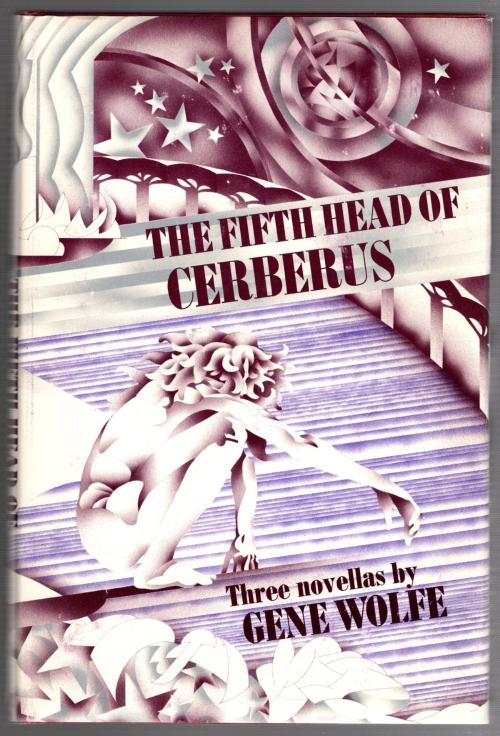
The Fifth Head of Cerberus by Gene Wolfe (First Edition)
Gene Wolfe The Fifth Head of Cerberus by Gene Wolfe (First Edition) A sharp tight copy. Bright gilt to spine. Pictorial dust jacket. Very minor edgewear. Not price-clipped. First Edition. No later printings listed. A collection of three novellas.- $100
- Heartwood Books and Art | 8 m
- $100
